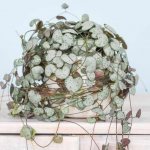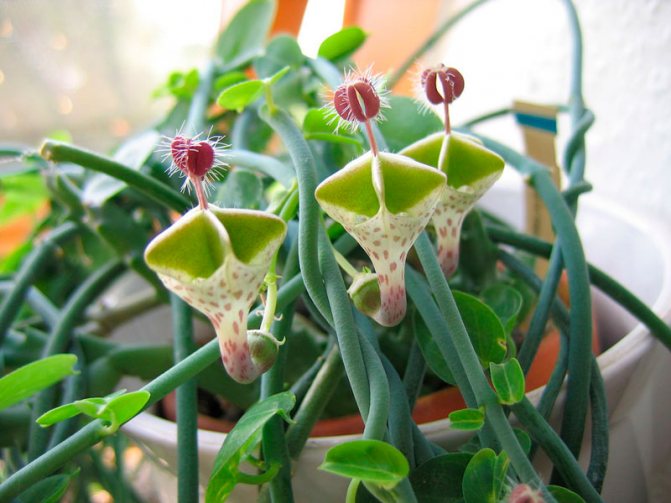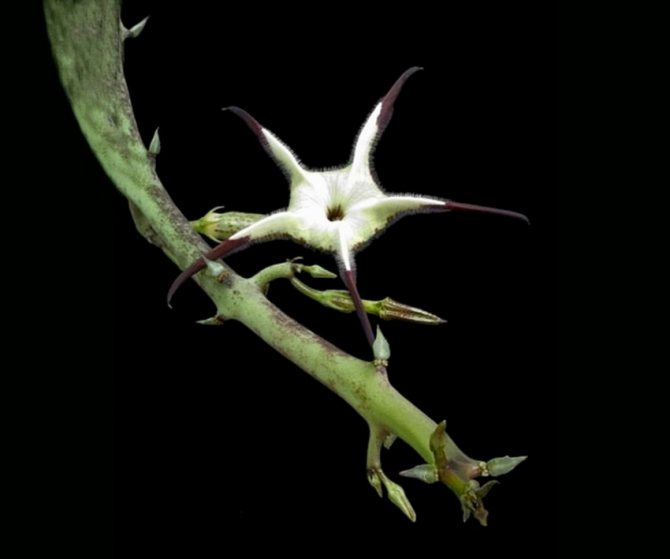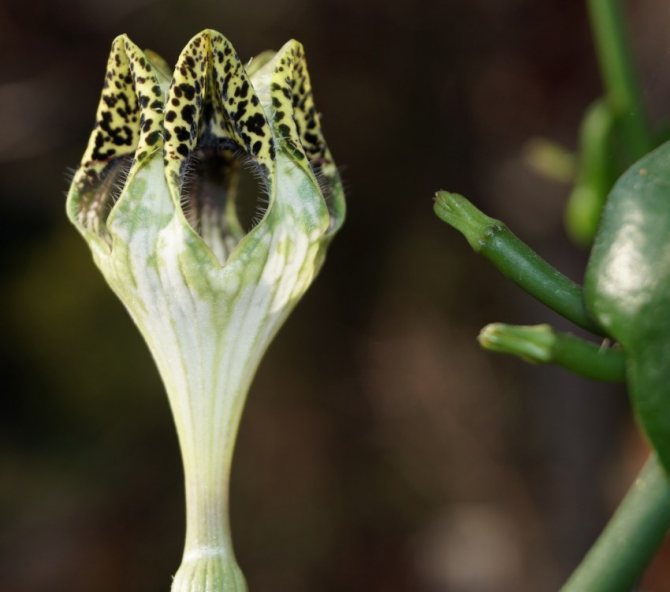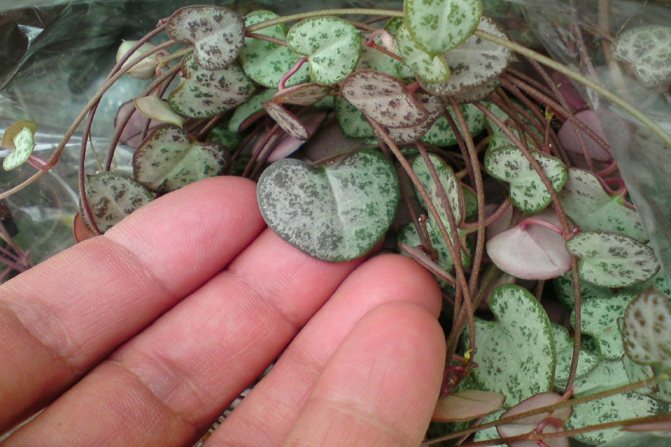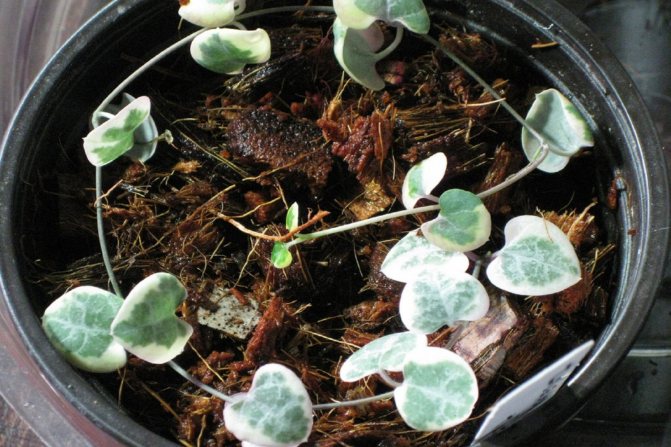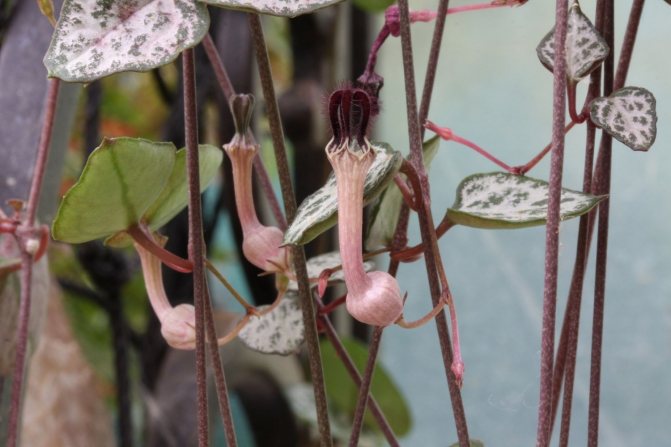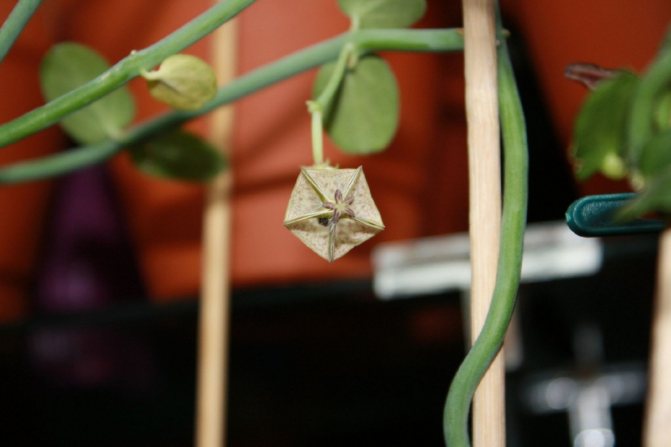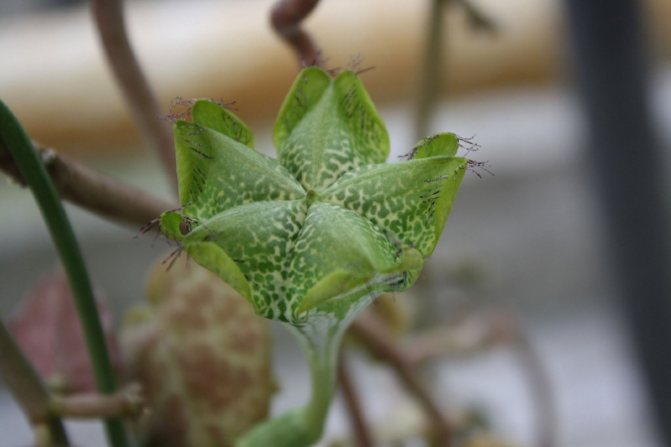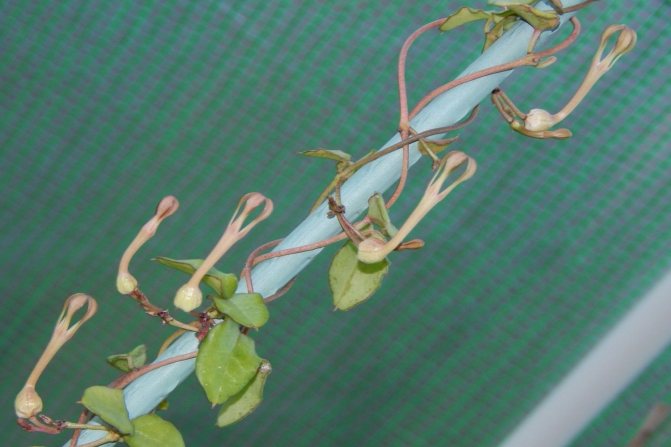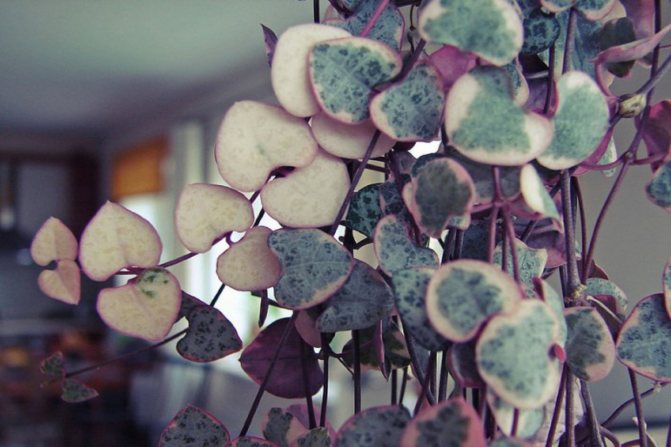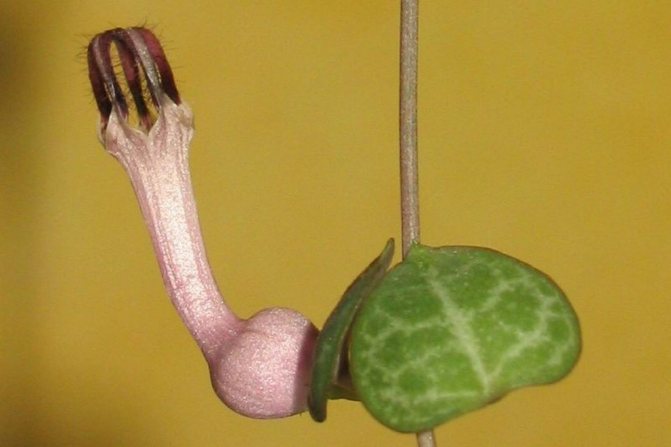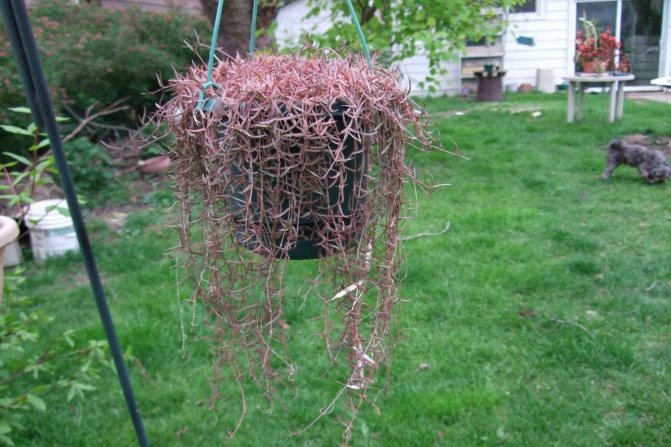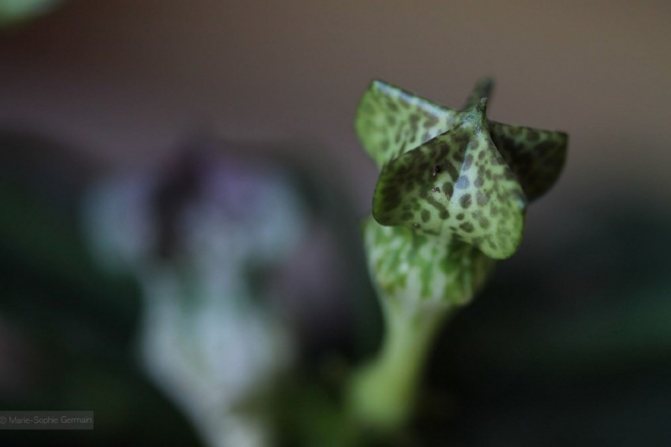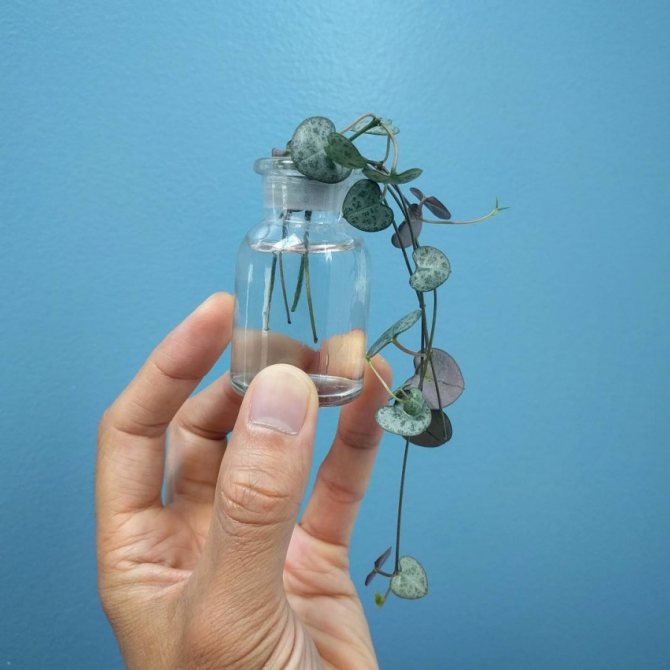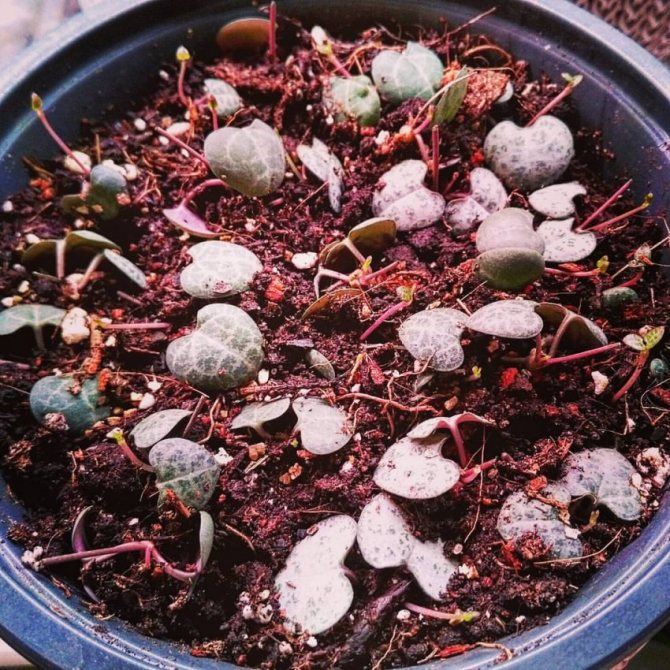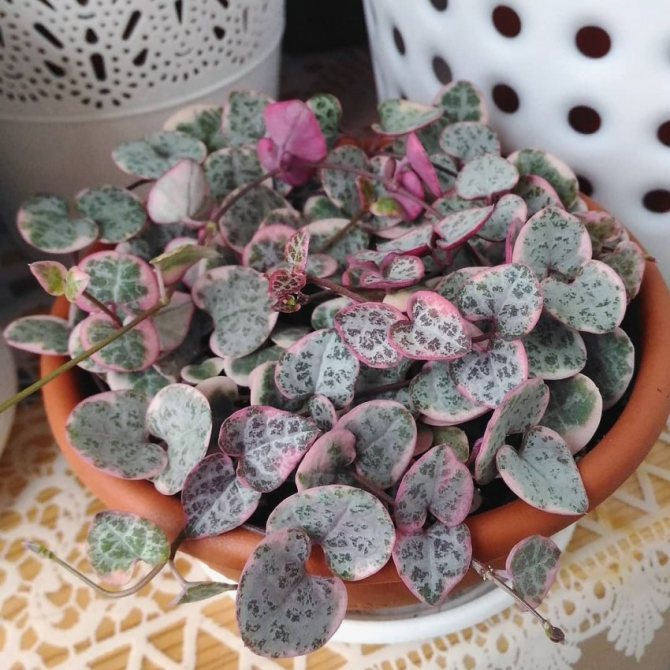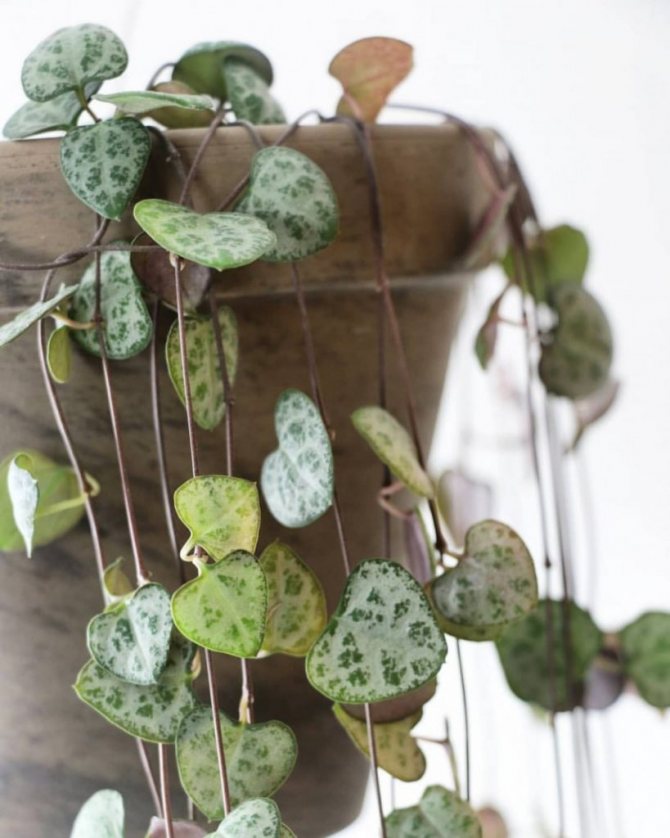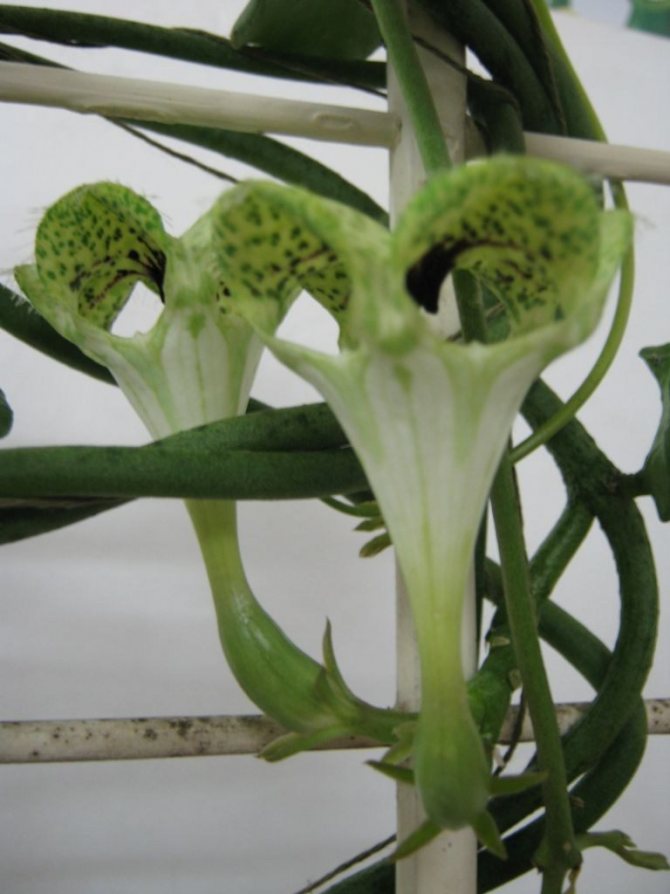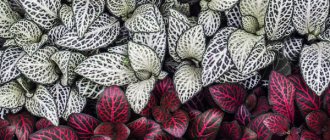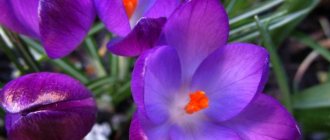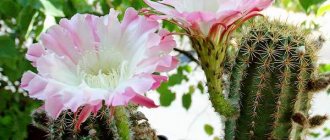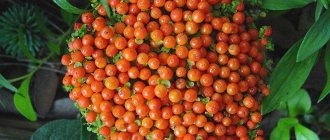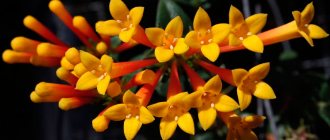Ceropegia (Ceropegia) is a perennial herb belonging to the Lastovnevye family. The closest relatives of ceropegia are hoyay, stapelia. Translated from Greek, the name of the plant means "candelabrum", "candlestick".
Ceropegia has a very original inflorescence. Singly or in several pieces, flowers of the most bizarre forms appear in the axils of the leaves: lanterns, necklaces, parachutes, fountains, antennas, pipes, they are raised. The petals from above and below are fused together - they form a semblance of a trap for pollinating insects. When an insect gets there, floundering in an attempt to get out, collects pollen on itself, then the flower opens and releases the insect. Thus, pollination occurs in the natural environment.
Botanical description
Ceropegia voodoo home care photo
The root system is tuberous. The leaves are mostly fleshy, thick, heart-shaped or lanceolate. The roots and leaves are organs that store moisture. Some ceropegia have no leaves at all - such plants are not grown at home.
Shoots are long, flexible. In some species, nodules form on the stems, which eventually release roots and sprout. Ceropegia is grown as an ampelous, climbing, creeping plant.
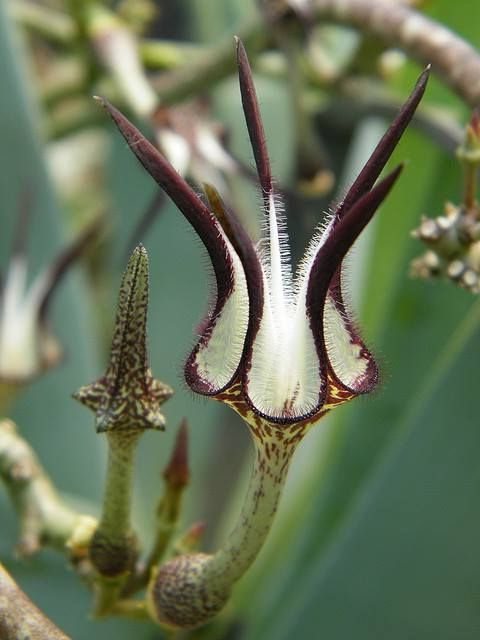
Ceropegia stapeliiformis Ceropegia stapeliiformis photo of flowering
The natural habitat is the southern part of Africa, can be found in the north of Australia, in China, India, on the islands of the Canary archipelago.
Despite the unusual appearance, unpretentious care, ceropegia can rarely be found in home floriculture. Take a closer look at this plant, because exotic ceropegia will be an excellent decoration for houses, apartments and other premises.
Description of the plant
Ceropegia is a herbaceous perennial in the form of a liana or a lodging shrub. The fibrous roots of the plant are quite thickened, they have small oblong nodules, in which ceropegia stores moisture in case of drought. Adult tubers release their own shoots, thus increasing the density of the crown.
Smooth, flexible stems are covered with a shiny dark green skin. The length of the vine in indoor specimens is about 1 m, but in the natural environment it can reach 3-5 m. The annual growth is up to 45 cm. Rare internodes are visible along the entire length of the stems. The distance between them can reach 20 cm. In internodes there are pairs of opposite leaves on petioles 1 cm long. Fleshy dark green leaf plates are ovoid or heart-shaped. The length of the leaf is 6 cm, and the width is 4 cm. There are varieties with a monochromatic and marbled foliage. On the reverse, lighter side of the leaf plate, a relief central vein is visible.
Axillary single flowers bloom along the entire length of the vine. They can form throughout the year. A large bud is located on short, thick peduncles. Its length can reach 7 cm. The funnel-shaped flower of white or greenish color resembles a small fountain or pagoda. No wonder the name of the plant can be translated as "wax fountain". The corolla grows together with the bracts and forms a five-pointed dome. The inner side of the tube has a faint pink tint.
After the flower wilts, the peduncle is preserved. Buds are formed on it many times. Gradually, additional internodes appear on the process, and it looks more like a lateral shoot.
Features of growing and care
Lighting and temperature
In nature, all species grow in the same temperature and climatic conditions, which are easy to create at home. There are a few general rules that must be followed in order for the plant to feel comfortable.
- All succulent plants (including ceropegia) are easily subject to root rot. Do not forget that the root of a vine is a tuber that accumulates water. Therefore, watering should be as needed. It is easy to identify by touch. Watering should be done only when the soil is completely dry.
- Every five to six years, the vine needs to be updated: old stems without leaves and flowers must be removed. Often young shoots are very confused, then it is very difficult to remove old ones. It is better to take care of this in advance and direct the young shoots to the right place.
- To create the green splendor of some species of these vines, you can plant several plants in one pot at the same time. Also, when creating a mini-garden of exotic plants, make sure that they all have similar growing conditions.
All ceropegias love direct sunlight. The longer the period of such lighting, the better. And in winter, with a short daylight hours, it is necessary to illuminate the plants with special lamps.
With a lack of light, the plant becomes scarce, stretches out and stops blooming. In the spring-summer period, you can take out the vines to the glazed loggia.
The temperature regime is very suitable for our apartments - as the plants perfectly tolerate the changes in day and night temperatures in spring and summer. In winter, to give them a dormant period, you need to lower the temperature to 16 -18 degrees. Such a place can be found on an insulated balcony or loggia.
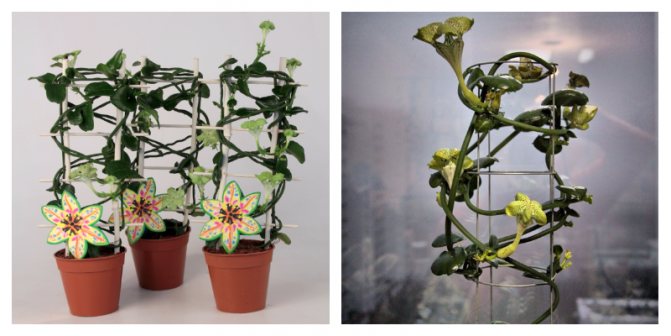

Air humidity
Plants are not adapted to humid air, the dry air of our apartments suits them better. But if you dry out the earthen substrate for a long time, the plant will wither and may even die.
The soil
The soil is common for succulents. Must be loose and include inorganic particles. This earthen mixture is easy to make yourself. This will require in equal amounts:
- Humus. Better to take in the garden. If you don't have your own, ask the neighbors. Check it for larvae, worms, and large non-rotting debris.
- Leafy land. Better to pick it up under deciduous trees. Also check for unnecessary impurities.
- Sod land. Urban land from the lawn is not suitable, you need land taken outside the city, away from roads.
- Coarse river sand, washed and disinfected in any way known to you.
- Finely crushed charcoal.
All must be mixed thoroughly. You can add some crumbs from red bricks and pieces of coniferous bark. If you find it difficult to independently compile an earthen mixture, you can buy a ready-made soil mixture for cacti and succulents in a specialized store. She's fine too.
Pot selection and transplanting
Choosing a flower pot is also important. It should have wide openings at the bottom to drain excess water. Moreover, the height of the drainage should be at least one quarter of the total volume! If these rules are not followed, the plant is threatened with decay of the rhizome. Otherwise, you will enjoy original greenery and amazing flowers.
A plant transplanted into a fresh substrate does not need feeding, but after a year it is worth feeding it. This is done every two weeks in the spring and summer. It is not necessary to fertilize the plant during the dormant period. As a balanced top dressing, a diluted 1: 1 fertilizer for succulents or orchids is quite suitable.
Annual transplanting is necessary only for young plants. Older flowers are transplanted once every two to three years. It is better to transfer from a smaller pot to a larger one, carefully adding fresh soil.
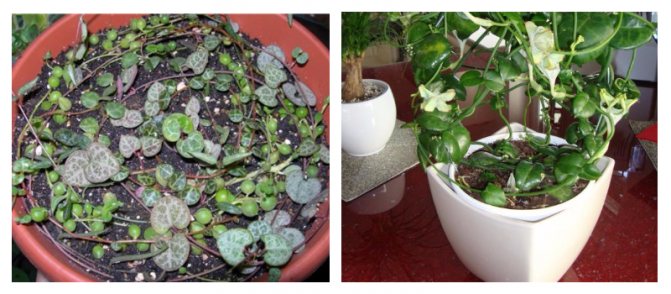

Pruning
Ceropegia does not need mandatory pruning. But for decorativeness, it is necessary to pinch long shoots, old and left without leaves and flowers, they spoil the whole appearance. Such shoots can be cut out completely. Pinching promotes branching of the stems. Young growth will decorate the top of the plant.
Flower care
One of the types of succulents that can be grown indoors is ceropegia. Caring for a plant at home is quite simple, but you should follow a few basic rules:
- Water the plant in a timely manner with a moderate amount of clean water.
- After five years, the plant needs to be renewed, as the old shoots become long, lethargic and lose many leaves.
- The use of a support is also an important step in growing a plant, as the stems of the flower are often confused at the time of growth.
- The temperature in the room should be from twenty to twenty-five degrees, since in the wild, ceropegia grows in hot countries. In winter, you can lower the temperature to fifteen degrees, but under such conditions, the stems of ceropegia will develop more slowly.
Features of the reproduction of the croton flower at home
Soil and fertilizing
A flower like Ceropegia is best grown in loose soil with the addition of inorganic elements. In order to prepare the land for cultivation, it is necessary to mix sod and leafy soil, humus, coarse sand and charcoal. This mixture will help prevent a number of diseases and root rot.
Land for planting seedlings can also be purchased at a specialized store. When planting a plant, it is better to use a pot that has a wide hole at the bottom so that excess liquid does not accumulate in the soil.
In order for the flower not to die, it must be fed in summer and spring; during other periods, feeding is not required.
The flower is practically not susceptible to diseases, but the formation of root rot is possible. Disease can come from too wet or heavy soil. Rot can also be accompanied by weakened stems and yellowed leaves.
Growing Chinese Schizandra, planting, pruning and care
If the leaves of the ceropegia begin to curl, and the shoots stretch out and become thin, then the plant must be placed in a more illuminated place. Excessive light may cause the leaves to take on a reddish or ruby hue.
Growing conditions: lighting, temperature, humidity
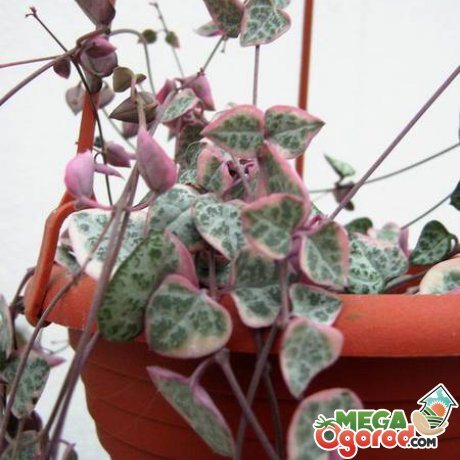

Ceropegia refers to plants that require a hanging planter. The pot should be wide, shallow and high. The plant loves places where it will be well lit by bright sunlight. Wood is not afraid to get burned by them, but at too high temperatures reddish spots may appear on the leaves.
Better that the light is diffused. With constant exposure to direct sunlight, the leaves will acquire a dark shade, and ceropegia will bloom later. The best place for her in the house would be southwest or southeast.
A tropical succulent plant cold-bloodedly tolerates both high temperature and a sharp decrease in temperature.
During the flowering period, the air in the room should warm up to 25 degrees above zero, and before winter rest, you can lower the temperature, bringing it to eleven degrees. Another parameter - humidity - is not an important condition for Wood's ceropegia. She easily tolerates the dry air of city apartments.
Despite the fact that the plant comes from warm countries with a humid and hot climate, it easily gets along in other conditions, adapting to them.
Types of ceropegia
There are about 180 species in the genus Ceropegia, but only a few of them can be found in houses. Most often, flower growers decide to buy Voodoo ceropegia. This herbaceous perennial has thin, sturdy green-brown stems. The dark green petiole leaves are modest in size. Their length is 1.5-2 cm, and their width is 1-1.5 cm. Darker spots are visible on the surface of the leaf plate. In places of internodes, rounded light brown tubers gradually develop. Lateral processes and aerial roots appear from them.
Axillary flowers form one at each internode. Beige or pink narrow tube has whitish pubescence inside. Dark brown petals are located on the surface of the flower.
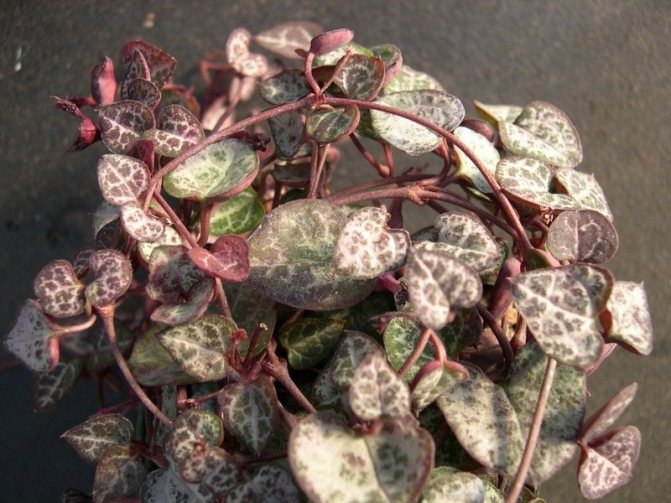

Ceropegia Voodoo
Africanan ceropegia. A perennial plant with a fleshy, drooping stem. In the internodes, juicy ovoid leaves are located. The length and width of the leaves does not exceed 1 cm. Small green-purple flowers cover the vine throughout the year. Above a narrow tube up to 2 cm long, there is a fused top about 1 cm high.
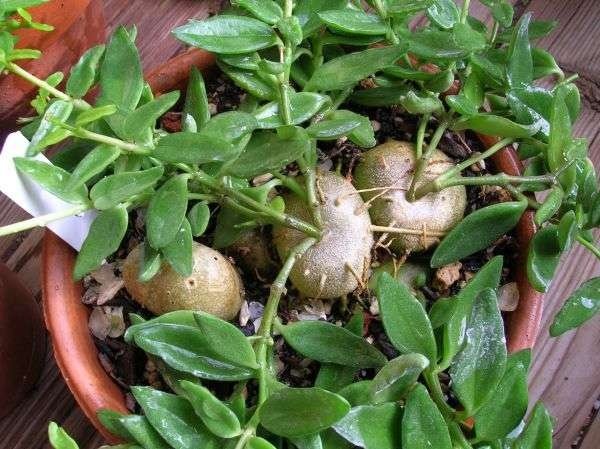

Ceropegia of African
Sanderson's ceropegia. The plant is distinguished by beautiful thick leaves and stems of a dark green saturated color. The length of the heart-shaped leaves is 5 cm, and the width is 3-4 cm. Beautiful large flowers reach 7 cm in length. Above the light tube is an umbrella made of fused light green petals. The inside of the pharynx and petals are covered with dark streaks and short pubescence.
Indoor views
There are several indoor plant varieties, you can find them in the table.
| View | Characteristic |
| Wood (voodoo) (ceropegia woodii) | One of the most common types, it takes root easily. The color of the leaves is marbled; in unopened form, they look like purple and green beads. It is one of the ampelous colors and resembles a Galein cross. |
| Sanderson's ceropegia | It has elongated, fleshy and smooth leaves of a dark green color. Placed in pairs along the stem. The branches are quite fragile, so the plant definitely needs support. Blooms throughout the year. Five petals fused together form a bud, which resembles a flashlight in shape. |
| Stapelium | This hybrid plant has a rather interesting appearance, and the presence of thick three-ribbed stems with antennae at the tops makes it possible to confuse ceropegia with some species of reptiles. The flowers are quite large, have a white color with purple dots and mini sizes. |
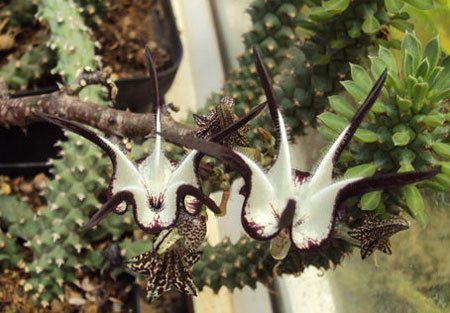

Strapelliform
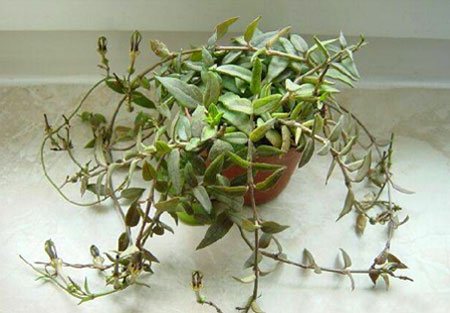

Barclay
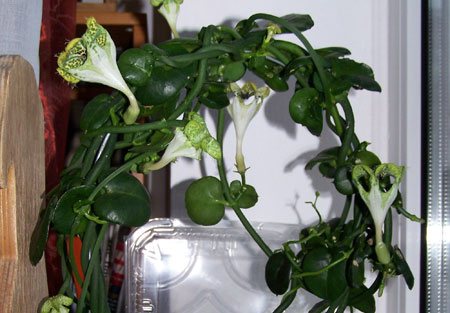

Sanderson
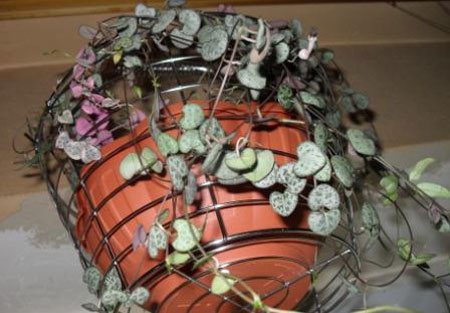

Voodoo or wood
Another popular type of indoor plant is Ceropegia Linearis, its image can be seen in the photo.
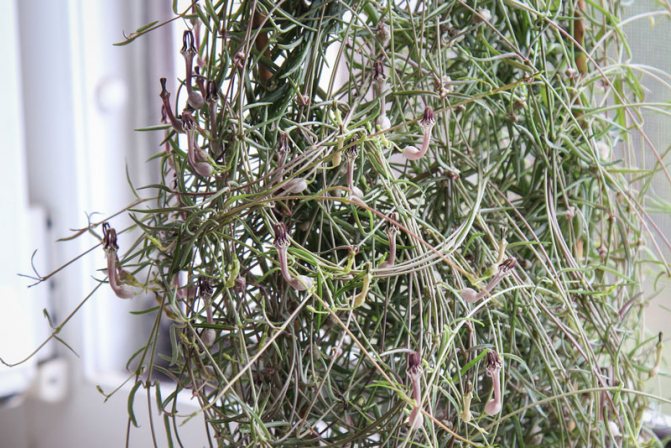

Ceropegia Linearis
Diseases, pests, other difficulties
Ceropegia has a fairly good immunity to diseases and pests.
Root rot is the main disease that occurs due to improper watering, low air temperature, heavy soil, or an oversized pot. The shoots will be lethargic, the leaves will begin to turn yellow and fall off. Get an emergency transplant. Remove the plant from the pot, cut off damaged roots, treat with fungicide. Replace the primer completely. Do not water immediately after transplanting. Then adjust watering.
It is extremely rarely affected by pests. Spider mites, aphids, mealybugs may appear. In this case, remove them mechanically: soak a cotton pad with soapy water and wipe the leaves, then treat with an insecticide.
Possible difficulties:
- From a lack of lighting, flowering may be absent, the shoots become thin, elongated, the leaves turn pale, curl.
- Exposure to direct sunlight leaves stains on the leaves.
- The stems and leaves dry out from lack of moisture.
Fight against succulent diseases and pests


Not very often the plant is affected by fungal infections, which are manifested by various rot, mold.You can fight them by spraying with phytoncides, washing the plant under running warm water.
In order not to bring the plant to disease, it is necessary to better monitor the condition of the soil, air temperature. High humidity leads to the appearance of fungi. As soon as the leaves begin to fade and the plant becomes lethargic, watering should be reduced. And if necessary, transplant a flower by changing the soil.
Of the problems in the growth of a succulent, the following can be noted:
- The stems become thinner, elongated, the leaves become small - the flower does not have enough light, it is necessary to choose a brighter side of the house for it.
- When ceropegia wood is not covered with flowers in spring and summer, it means that it has little light and nutrients.
- The yellowness of the leaves and their falling off is a signal that the plant is cold, and the ground in the pots is excessively wet.
Of the pests, rarely anyone attacks a tropical alien. Spider mites can sometimes be found, but they can be dealt with quickly. The pest settles on the inside of the leaf, sucking the juices, enveloping the flower with cobwebs. You can get rid of the mite by spraying the infusion of onion peels. To do this, take 20 grams of husk and fill it with a liter of hot water.
It is necessary to process the plant three times with an interval of ten days. Pollination of the underside of the leaves with powdered sulfur is also effective. Insecticidal preparations such as Intavir will help to destroy the pest.
Ceropegia Wood is a wonderful flower that does not require special care and is distinguished by good health.
Ceropegia can be infected with aphids from other plants. If it appears, it is necessary to spray the leaves with a decoction of tobacco, which is prepared from half a kilogram of tobacco waste or tobacco dust for two liters of water. The solution is insisted for a day, and then diluted by taking two tablespoons per liter of water. Other insects bypass the tropical plant.
More information can be found in the video:
Ceropegia wood and her photo
Ceropegia wood (Ceropegia woodii Schlecht.). Gusset family. Homeland - South Africa. A graceful evergreen herb with numerous intertwined thin, threadlike light green creeping shoots.
As you can see in the photo, in Ceropegia wood, filamentous leafy shoots form a continuous rug on the substrate and hang down from the edges of the dishes:
The leaves are rather small, opposite, obtuse-triangular-oval, on short thin petioles. On the upper side, the leaf blade is whitish-green with marble painting, which gives a matte tone to the leaf. On the underside, the leaves are whitish with a pink tint, the central vein is clearly visible, it is dark green. The internodes are rather long - 3-4 cm. The flowers of the ceropegia are cylindrical, small, reddish, and consist of a calyx and a corolla with stamens and a pistil. Blooms from late summer to late autumn. The roots of ceropegia are thin, slightly branched, not numerous.
The plant is interesting in that in the nodes of the shoots, especially with age, light yellowish nodules develop, which give the whole appearance of the plant a bizarre and peculiar look. Nodules in a humid atmosphere and in contact with a moist substrate, for example, with expanded clay, quickly develop several thin roots and serve for reproduction.
Sanderson's Ceropegia Care
We have wanted this "alien" for a long time in our collection of house plants. And three years ago the dream came true - we got a stem several centimeters long.
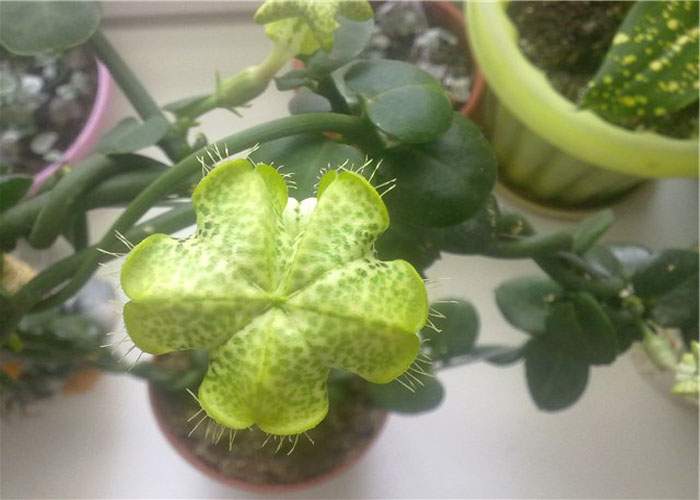

Sanderson's ceropegia grows quickly - just manage to tie it to a support, which, by the way, must be foreseen in advance. Shoots are fragile and must be handled with care.
The primer was suitable for universal use with the addition of perlite. At the bottom of the flowerpot there is a high layer of expanded clay. Despite the fact that ceropegia belongs to succulents, she drinks a lot, especially in the heat. I water abundantly, regularly, but only after the soil dries.
There is a plant on the east window, basking in the sun until lunchtime, I do not shade. It tolerates dry air perfectly.
In autumn and winter, I limit watering, put it closer to the glass, where it is cooler. Overflowing at this time can destroy the plant. Sometimes in winter, some of the leaves fall off - the lack of light affects.
In the spring, I must shorten the bare shoots by 2/3.
The plant responds well to transplanting into fresh soil - buds appear immediately. During the summer, I feed with fertilizer for cacti.
Ceropegia is resistant to pests, but for prevention I treat it along with other plants.
How to care for ceropegia at home
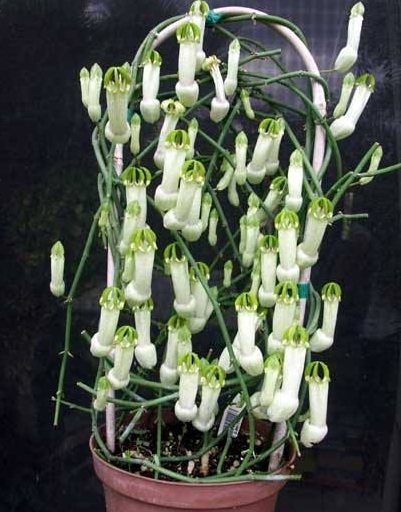

Ceropegia ampelous photo
In leaving, ceropegias are unpretentious, even beginners are able to cope with them.
There are some nuances:
- Ceropegia is a succulent plant. It is necessary to water moderately so as not to provoke rotting.
- Over time, the shoots stretch out, the leaves fall off, the plant loses its attractiveness, so a transplant is required every 5 years.
- Immediately provide a suitable support from which you can quite easily remove the plant during transplantation.
- Plant several shoots in one container to make the bush more lush.
Site selection and lighting
Ceropegias love light and warmth. Lighting must be diffused, without direct sunlight. The best place would be east and west facing windows. Placed on the south side, provide shading. When placed on the north window, additional lighting with phytolamps will be required. Daylight hours should be about 12 hours.
Air temperature
Keep the air temperature between 21-25 ° C in spring and summer. In order for the plant to "rest", keep the air temperature at 15 ° C in the autumn-winter time. If wintering is warm, be sure to use artificial lighting.
Watering and humidity
Balanced watering is important. Drying out or too much moisture can destroy the plant. Overdrying an earthen coma leads to leaf fall, flooding provokes rotting.
In the summer, water abundantly as the topsoil dries up, in the fall - in moderation, and in the winter (with a cool winter), it is enough to water once every 2 weeks. If the plant hibernates in a warm place with additional lighting, leave watering "summer".
There are no requirements for air humidity. For hygiene purposes, occasionally spray the plant, wipe the leaves from dust with a damp sponge.
For watering and spraying, use soft, settled water at room temperature.
Top dressing
In the spring-summer time, every 2 weeks it is necessary to make top dressing. Use fertilizer for succulent plants or orchids, dilute at half the concentration recommended by the manufacturer. The rest of the time, as well as young plants, you do not need to feed.
Pruning
Ceropegia does not need planned pruning. It is carried out to maintain decorativeness. Shorten shoots that are too long or broken off. Pinch the tops of the shoots to stimulate tillering.
Place and lighting for ceropegia
Ceropegia is a light-loving and heat-loving plant. But it is also necessary that the rays of the sun do not fall on this flower.
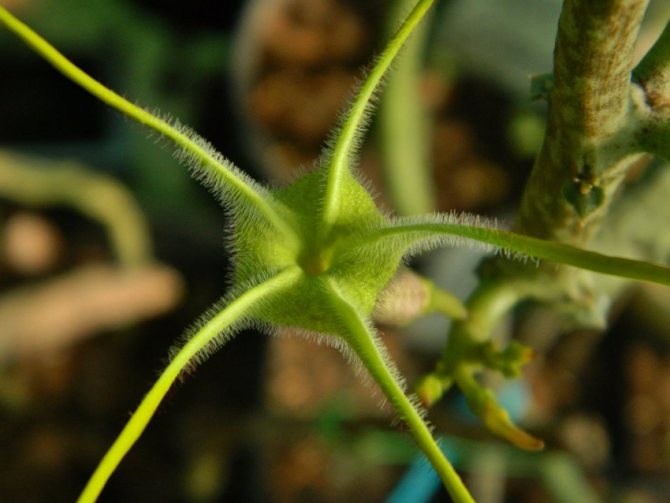

The best place for them would be the west or east window. If you place it in the south, then you need to find an opportunity for shading. In the northern part, the plant needs special lighting, which the flower needs for about 12 hours a day.
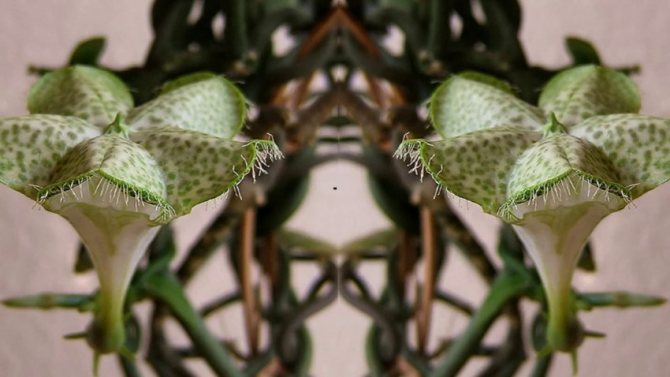

Types and varieties of ceropegia
In room culture, four types of ceropegia are most often grown.
African Ceropegia (Ceropegia africana)
- herbaceous perennial with fleshy creeping shoots, small, smooth, thickened ovoid or linear leaves and small dark purple or green flowers with a corolla tube up to 2 cm long and petals converging tops.
In the photo: Ceropegia woodii
Ceropegia barklyi
- also a herbaceous perennial with a rounded, slightly branched tuberous rhizome, fleshy, usually bare, but sometimes pubescent shoots and light green ovate-lanceolate leaves with whitish veins, 2.5 to 5 cm long, sitting on short petioles. The flowers of this ceropegia, green on the outside and purple on the inside, reach a length of 5 cm and are collected in umbrellas. Their fibrous petals, triangular at the base, are pointed towards the apex.
Ceropegia flower - description
Ceropegia is an erect or climbing herbaceous perennial with a tuberous or thickened fusiform rhizome, in which the plant accumulates moisture in reserve. The stems of the representatives of the genus are creeping, fleshy, the leaves are small, thickened, ovoid, linear or lanceolate, located opposite. The leaves and stems of most species are succulent. The juice of ceropegia is usually not milky, but transparent. Large axillary five-membered flowers, collected in brushes or umbrellas, have a tubular corolla widened at the base. The stamens of the flowers grow together into a tube. Fruits of ceropegia are cylindrical, fusiform or linear leaflets.
Growing from seeds


Seeds of ceropegia photo
Ceropegia seeds are difficult to find on sale, and it is impossible to collect at home. If you managed to get them, sow in the spring.
- Sow in light soil, the seeds are planted one, two or three in one cup so as not to dive.
- Cover the crops with foil, maintain the air temperature within 20-25 ° C, regularly ventilate, spray.


Ceropegia from seeds photo of seedlings
- The seedlings are grown with moderate watering and good diffused lighting, after which they are transferred into permanent pots, several vines into one, to create a lush bush.
Ceropegia is a beautiful tropical vine that definitely deserves your attention. She will delight you with unusual flowering and beautiful leaves.
Botanical description
This flower has a tuberous root system. The leaves are very thick, heart-shaped, and accumulate water. There is also such a phenomenon when a flower has absolutely no leaves, such a plant is not able to take root at home. The branches are very long and elastic, and in certain species there are nodules on the shoots, with which this plant then reproduces.
Tseropegia begins to grow in the subtropics of southern Africa. Also, it can be seen in India, China and Australia.


The uniqueness and simplicity of Ceropogea attracts many. That is why it is found in the houses and apartments of florists. After all, this flower can be a good decoration in a living room.
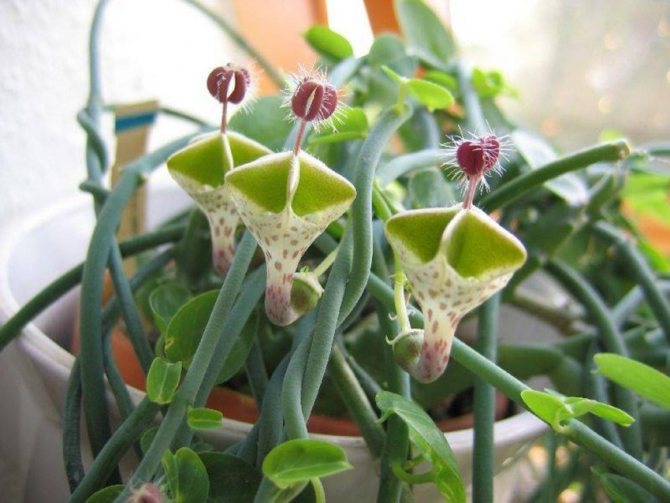

Competent plant care: watering, feeding


At the heart of Wood's ceropegia care are such important procedures as watering and feeding:
- A flower grows best when the soil is moistened two to three times a week when it begins its growing season. Although the plant tolerates drought well, the soil dried out to the roots can lead to the death of the succulent. Therefore, if the topsoil begins to dry out, then this is a signal for watering. It is better to water with warm, well-settled water.
- To feed ceropegia, special complexes are used, produced for succulents and cacti. The use of nitrogenous fertilizers should be avoided. The plant is fed twice a month, and in winter, nutritional procedures are stopped.
Despite the unpretentiousness, pickiness of the flower, it needs care in accordance with the rules of agricultural technology.
Watering and moisture
During watering, you must observe the measure. If you water a little or vice versa a lot, then this can lead to the fact that the plant will die. With dry soil, the leaves will fall off. If you pour it heavily with water, the plant will start to rot.
Watering abundantly is necessary in the summer, you need to pay attention to the topsoil, it should not be very dry.In the cold season, watering is enough 2-3 times a month. If the room where the flower is warm, then the watering regime should be the same as in summer.


As for the humidity of the air, there are no specific criteria here. To keep the plant healthy, you need to wipe the leaves from dirt with a wet rag or sponge.


Water for irrigation should be used at room temperature. It is important that it is soft and stable.
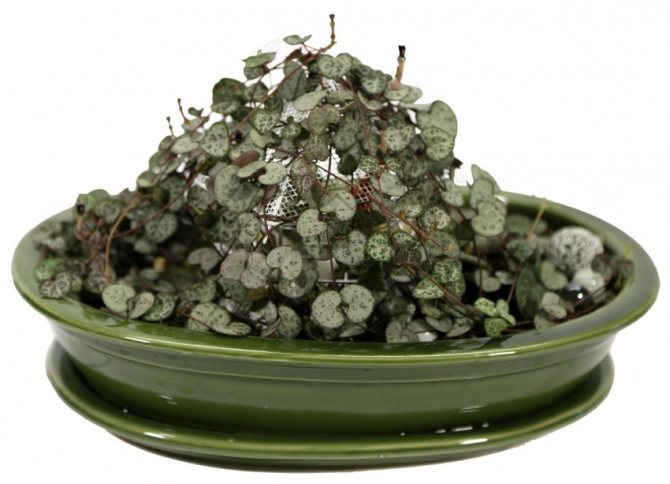

Reproduction methods
Reproduction of ceropegia is carried out by dividing the rhizome, rooting cuttings or sowing seeds. This process is painstaking and lengthy.
You can buy ceropegia seeds online or at major flower shops. In the spring, prepare a box with a sandy-peat substrate. The seeds are spread over the surface and crushed with the thinnest layer of soil. Until the emergence of shoots, the pot is kept under a film in a bright place at a temperature of + 20 ... + 25 ° C. Seedlings hatch in 14-18 days. The grown seedlings dive into separate pots.


In the spring, you can cut several cuttings with 2-3 internodes. Root them in moist fertile soil. If air nodules are present on the handle, then the likelihood of a positive outcome increases significantly. It is necessary to dig in the stems at an angle or horizontally so that the internodes are in contact with the ground. The pot is covered with foil, kept in a bright place and regularly ventilated. The air temperature should be + 18… + 20 ° C. When the plant takes root and starts sprouting, you can transplant it to a permanent location.
When transplanting, the root of an adult ceropegia can be divided into 2-3 parts. Each should contain several tubers and growth buds. Usually, liana easily tolerates this procedure and does not require additional care.
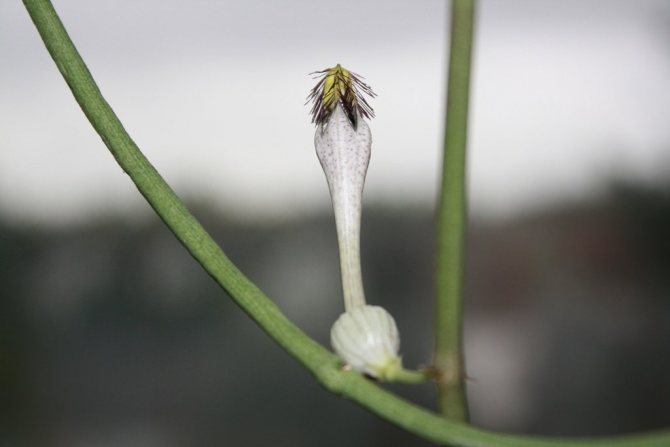

Care features
The plant is unpretentious in cultivation, it gets sick very rarely. Reacts to proper care with amicable flowering and rapid growth.
- Temperature. Calmly endures the heat. The optimum temperature for harmonious development is 21-23 ° C during the daytime, 10-15 ° C at night.
- Lighting. It is recommended to put on the windowsills of windows facing west or east. Loves bright light, but suffers from the hot summer sun. Therefore, on the south side, partial shade is created for the plant with the help of light tulle.
- Watering. The soil should be slightly damp. Watering is rare - in the summer, twice a month, in the winter - once every three weeks. If the summer is hot, then watered a little more often, as the topsoil dries up by 2-3 cm.
- Humidity. Feels great in an average humidity of about 40-50%. Lower air humidity does not affect growth and flowering, so it does not need to be sprayed.
- Top dressing. Top dressing is carried out monthly for the entire growing season, using preparations for succulents. The plant responds gratefully to the application of organic fertilizers.
- The soil. Light soils are suitable, consisting of 3 parts of humus, 2 parts of peat and 1 part of sand. A drainage layer of expanded clay is poured onto the bottom of the pot. You can use ready-made soil mixtures, adding a small amount of perlite and sand to them for loosening.
- Transfer. Only highly overgrown plants are transplanted once every 3-4 years. Shoots are fragile, so you need to act carefully. The roots are not freed from the ground, they are transplanted together with a lump, adding fresh soil.
Advice! If the shoots of ceropegia get tangled, it will be problematic to separate them. To prevent this from happening, it is better to grow it in hanging baskets or on a support in the form of an arch.
Photo
The photo shows the plant "Sanderson's Ceropegia":
Possible growing difficulties
With home cultivation, ceropegias rarely get sick.
Find out if you can keep a monstera flower at home.
When the substrate is overwetted, one of two problems may arise:
- root rot - in such cases, it is rarely possible to completely save the plant, it is better to root the available healthy tubers, leaf or root;
- powdery mildew - it is eliminated by transplanting and removing the affected parts of the plant, the roots are treated with a mixture of wood ash with "Fundazol" in a 1: 1 ratio.
Of the pests, mealybugs can settle on ceropegia. Eliminate it by treating plants and soil with tobacco dust. So, Wood's ceropegia is perfect for landscaping any premises. The plant is attractively high decorative and unpretentious. Observing the basic rules of care, you can achieve year-round flowering.
Pests and diseases of ceropegia
Diseases of ceropegia and their treatment.
Ceropegia suffers from fungal diseases - mainly rot, which develop due to poor or improper care. Avoid waterlogging of the plant and stagnation of water in its roots. If rot does develop, remove the ceropegia from the pot, inspect its roots, remove all rotting areas and hold the root system for half an hour in a fungicidal solution, then let the roots dry and plant the plant in a fresh substrate.
Under the wrong conditions, ceropegia can get a sunburn of the leaves, and from a lack of light, its stems are painfully stretched out.
In the photo: Cultivation of ceropegia on a windowsill
Pests of ceropegia and the fight against them.
At home, mealybugs, aphids and spider mites can annoy ceropegia. All these pests are sucking: they bite through the succulent leaves and stems of ceropegia and feed on its cell sap, which makes the plant weak, becomes lethargic, its leaves turn yellow and wither prematurely, and the shoots and flowers are deformed. In addition, sucking pests carry dangerous viruses from which it is impossible to save the plant. If you find a danger at the very beginning of the occupation, it is enough just to wash the ceropegia under a warm shower, but if the pests have proliferated, take the flower out into the open air and treat it over the leaves with Actellik or Fitoverma solution.
Diseases and pests
The most common disease to which ceropegia is exposed is rot, and it is associated, most often, with a violation of the conditions of maintenance and care, namely, frequent and abundant watering, which leads to rotting of tubers. The first signs may be the pallor and lethargy of the stems.
- The reason that the stems are too stretched, and the leaves become small at the same time, may be a lack of nutrients and / or lighting.
- When the leaves turn yellow, and then completely fall off, it means either the soil is too wet, or the air temperature is below optimal for a given time of year.
- The absence or cessation of flowering is a lack of light.
- Redness of foliage is a consequence of sunburn.
- Curling of leaves and their pallor - little light.
Pest infestation is insignificant. But it's better to know how to deal with them. So, for example, when a mealybug appears, it is necessary to wipe the leaves with an alcohol solution. And insecticides will help in the fight against aphids.
With a spider mite, at the initial stage, with a minor defeat, folk methods will cope: infusions of yarrow, onion or garlic, but if the pest does not recede, then it is necessary to use heavier artillery, in the form of drugs such as Actellik, Karbofos and the like.
External features of the plant


The plant got its name from the shape of the flower, which resemble both a parachute and a stylized fountain of water, frozen for a while. Ceropegia is a variegated plant in which not all cells synthesize chlorophyll. Hence the light spots, merging into an unusual pattern, on thin heart-shaped leaves. In strong light, the color of the leaves becomes more intense.
The decorativeness of all its parts attracts in a tropical flower.
The root of the flower is a strong gray tuber with a purple tint. As ceropegia grows, miniature nodules form in the leaf axils.They retain moisture well, so such a plant is not afraid of drought. These light yellow tubers are the plant's propagation material.
Description
From ancient Greek, ceropegia is translated as "candelabrum". This name was given to the flower due to its extraordinary shape, which often differs depending on the species. Some have erect stems, while others have climbing and creeping stems.
The leaves resemble a heart, light green in color with small dark green blotches. Ceropegia is one of the variegated colors, i.e. having mutant cells that are incapable of producing chlorophyll. The word "variegata" from English means "spotted".
Correct plant transplant, propagation methods
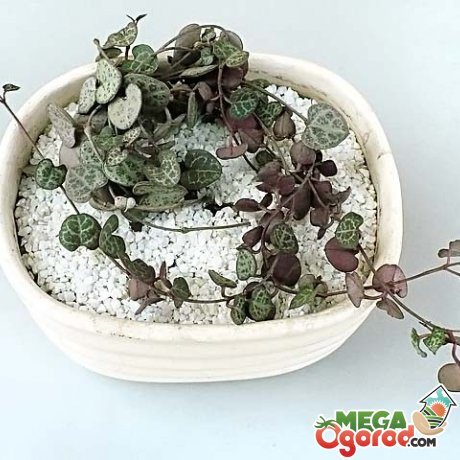

Ceropegia Wood needs transplants, so young plants are transferred to new pots annually, and adults - once every two or three years. The procedure contains a number of requirements:
- Pots are selected so that it is not too spacious.
- Be sure to place a drainage layer on the bottom of the container.
- A soil mixture of leafy earth, humus, sand is poured into the pot.
- It is important to add a little slaked lime and charcoal to the soil.
- The plant is transferred to another container, carefully placing the underground tubers and sprinkling them with soil. There is no need to untangle the stems.
If the transplant rules are followed, then the plant will not hurt, but only bloom profusely.
Of the available methods of plant propagation, cuttings can be noted. Cut shoots up to ten centimeters long root easily in wet sand at an air temperature of 17 degrees. Reproduction by tubers, which appear over time in the leaf axils, is also easy. For this method, it is necessary to cut off the shoots with two leaves and nodules and plant them in wet sand. Once they are rooted, the seedlings are placed in a separate pot.
Seed shoots appear quickly, especially when containers with them are placed in a polyethylene greenhouse. They need warmth and good watering. For ceropegia, ease of reproduction, growth, flowering is characteristic.
Transplant of ceropegia


How to transplant ceropegia photo
Young plants require an annual transplant. More adults are transplanted every few years. Transfer together with an earthen clod.
The container needs to be wide, not deep, with large drainage holes. The drainage layer should occupy ¼ of the volume.
The soil needs light, loose, water and air permeable. Suitable substrate for succulents or cacti. If possible, prepare a soil mixture: mix in equal proportions leafy, turfy soil, humus, river sand, add a little charcoal, pine bark, brick chips.
Reproduction by nodules and dividing the bush
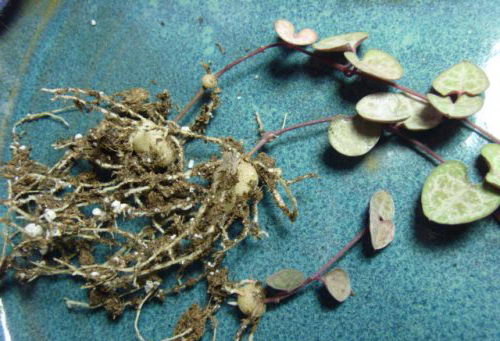

Reproduction of ceropegia by nodules photo
Wood's ceropegia successfully reproduces by nodules formed on the stems. Cut off part of the shoot with a nodule and a couple of leaves, root in the sand.
When transplanting, divide the rhizome. Remove the plant from the pot, divide it into parts with a sharp knife, each division should be with a well-developed root system and several shoots. Treat the cut points with a fungicide, plant the cuttings in separate containers.
Reproduction
Ceropegia can be propagated in several ways. Those plants that form air nodules are best propagated by cuttings with them. You can propagate:
- Regular cuttings.
- Seeds.
- By dividing the rhizome.
Cuttings intended for propagation must be dried for two to three days. They should have from three to five internodes. Then the prepared cuttings need to be pinned to a substrate of peat and sand (sold in flower shops) or to clean, wet sand without interstitial admixture to the soil. Be sure to cover with foil to create the necessary humidity, but do not forget to ventilate. Place the scion pot in a sunny place.
Seeds of various types of Ceropegia can be purchased at flower shops, but rare species can be found in online stores. Seeds are evenly distributed on the prepared substrate and lightly sprinkled with soil. Cover with foil and put in a bright place. Shoots appear in about two weeks, sometimes a little later. The film is removed for airing, and after two sheets appear, it can be removed completely. Expand the grown seedlings into separate pots.
You need to divide the rhizome when transplanting an old plant. It is necessary to divide the rhizome in such a way that on each of the parts there are growth buds and a significant part of the tubers. Ceropegia tolerates such reproduction most painlessly.


Propagation of ceropegia by cuttings
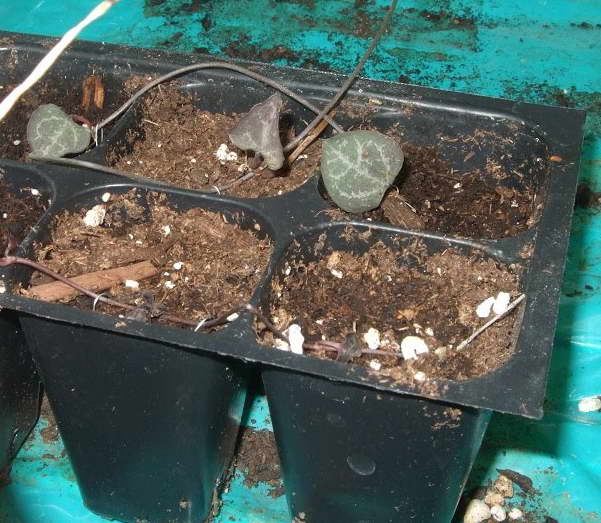

Cutting of ceropegia photo
Cutting is the most popular method.
- The stalk should contain 4-8 nodes, long cuttings are not separated, but pinned, sprinkling with earth.
- Root in early spring.
- Places of cuts should be slightly dried, treated with a growth stimulant.
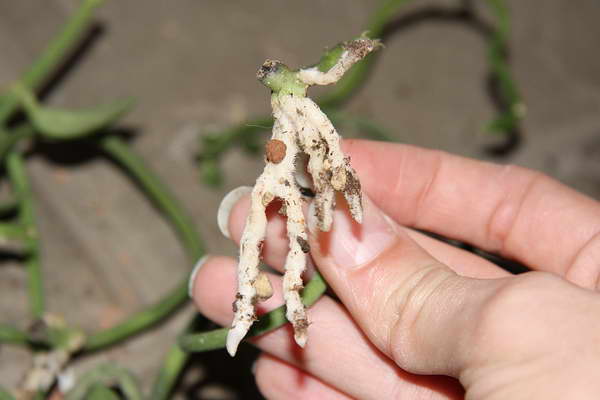

Rooted cuttings of ceropegia photo
- Can be rooted in a sandy-peat mixture or sand.
- Cover with foil on top, place in a bright place, maintain the air temperature at about 24 ° C, ventilate regularly, pour with warm water.
Optimal conditions for growth
Hardy Wood's ceropegia are not whimsical at all in terms of microclimate.
Lighting
In the presence of high-quality illumination, the flowering of Wood's ceropegia can continue almost all year round. She is not afraid of short-term contact with direct sunlight. Plants are best placed on the east or west side of the room.
Important! The brighter the diffused lighting, the higher the decorativeness of the leaves - the pattern on the outside becomes brighter. But prolonged contact with the open sun can lead to burns.
Airing
In the summer, it is better to rearrange the plants on the balcony. In winter, it is imperative to ventilate, but avoid drafts.
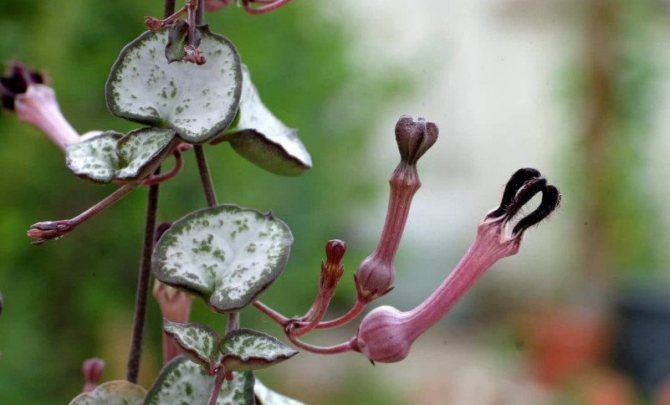

Temperature regime
Ceropegia is absolutely not demanding on the temperature regime and perfectly tolerates temperature changes from + 10 ° С to + 27 ° С. But in order to achieve year-round flowering, it is better to maintain a constant temperature within + 20 ... + 23 ° С.
Air humidity
Air humidity can be any. Additional moistening of the area around the plant and spraying is not required even in the driest periods.
Learn how to properly plant indoor flowers in a pot.
Types of ceropegia with photos and names
The genus ceropegia has more than 250 species.
Ceropegia suitable for home floriculture can be divided into 5 groups:
- Plants with rather thin, non-fleshy leaves.
- Tuberous varieties with both thin and fleshy leaves.
- Ceropegia with thin shoots.
- Liana-like ceropegia with very juicy stems, tiny leaves.
- The stems and leaves are succulent, the plant curls.
Most often, Wood's ceropegia and Sanderson's ceropegia are grown in room conditions.
Ceropegia Wood Ceropegia woodii cultivation and care
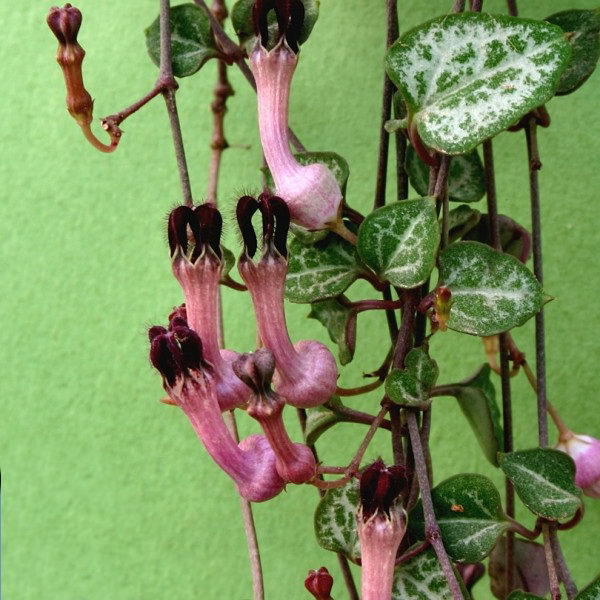

Ceropegia Voodoo Ceropegia woodii photo of flowering
Ceropegia voodoo is the most popular species. It has thin, graceful stems, painted in a brown-purple hue, the shoots hang down from the pot in a thick net. Young leaves have a light green or lilac color, they are strung on the shoots, like beads. Old leaves are thin, wide, and become marbled.
In summer, light nodules, similar to potatoes, appear directly on the shoots. They are used for plant propagation, and it does not matter which end to place the tuber in the soil - it will still take root and give shoots.
Flowering lasts all summer and part of autumn. Tubular flowers appear in the axils of the leaves, inside they are pubescent. Moreover, flowers bloom on both old and new shoots.
Wood's ceropegia is a succulent plant.It will bloom well even without high-quality watering and fertilizing, it multiplies very easily: it is difficult to find a less unpretentious plant.
Best grown in hanging pots. You can use stands of various shapes, which flexible shoots will successfully braid, but when the time for transplanting comes, it is quite problematic to untangle the composition - damage to the plant is possible.
Houseplants
Such a succulent as ceropegia is quite rare, and you can buy it only at specialized flower exhibitions. Wild ceropegia grows on the African continent, on the northern coast of Australia, in the Canary archipelago and in China.
The flower is a perennial and has many species. The leaves of the plant are heart-shaped, but you can find flowers completely devoid of greenery.
Types of ceropegia
The most popular are Sanderson's ceropegia, African, graceful and Wood's ceropegia. Home care for such flowers will not be difficult. Each species has its own characteristics and structure of the flower.
- Ceropegia Wood is the most popular type of plant. The stems of the flower are pale purple in color, the old leaves are slightly marbled, and the new ones are bright green. This type of ceropegia blooms regardless of the season. When a plant forms small glomeruli and their subsequent contact with the ground, the flower gives roots.
- Sanderson's Ceropegia, when properly cared for, can delight with its flowering year-round.
- You can find a flower with thick stems, which are unusual for ceropegia. This type is called stapeliform and differs from others in triangular-shaped leaves and small burgundy inflorescences with white blotches.
- The African kind of flower is almost impossible to find in flower shops. It is distinguished by small bright green leaves and inflorescences in the form of small lanterns.
Mammillaria Zeilman: types and care of a cactus at home
We also recommend reading: Varieties of dangerous and useful indoor plants Description of the Venus flytrap and where the predatory plant lives Reproduction and care of the indoor flower Tradescantia Amaranth plant and its distinctive properties
Types of ceropegia, popular in indoor cultivation
According to the Internet project The Plant List, about 217 species of herbaceous perennials and climbing plants are ranked in the genus Ceropegia.
Wood's ceropegia (C. woodii) is the most popular species in culture with a large tuberous root, from which several thin, almost threadlike, drooping stems grow. The pagons reach about 2 m in length, covered with fleshy leaves in the form of a kidney or heart.
On the upper side, the color of the leaf blades is light green, with a silvery pattern, and on the bottom, with a slight pinkish tinge. Corollas, similar to small candles, are painted in white, light purple or purple. Appear continuously throughout most of the year.
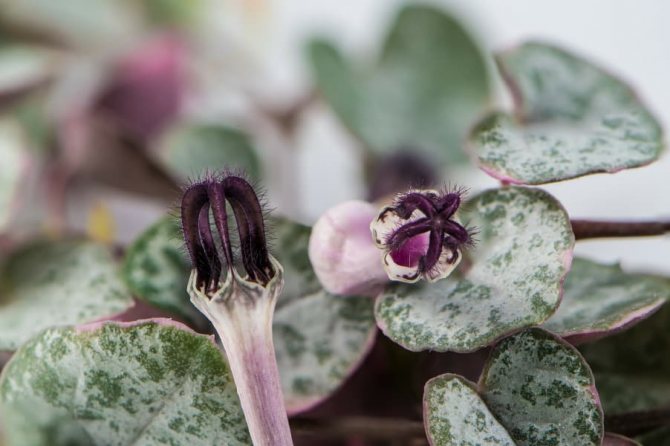

Graceful ceropegia (C. elegans) is a perennial with spectacular creeping pagons, evenly covered with elongated, shortly pointed at the apex, ciliate leaves. Tubular corollas form a small-flowered umbellate inflorescence. The tops of white petals with a purple or purple-cherry pattern are also decorated with delicate cilia.
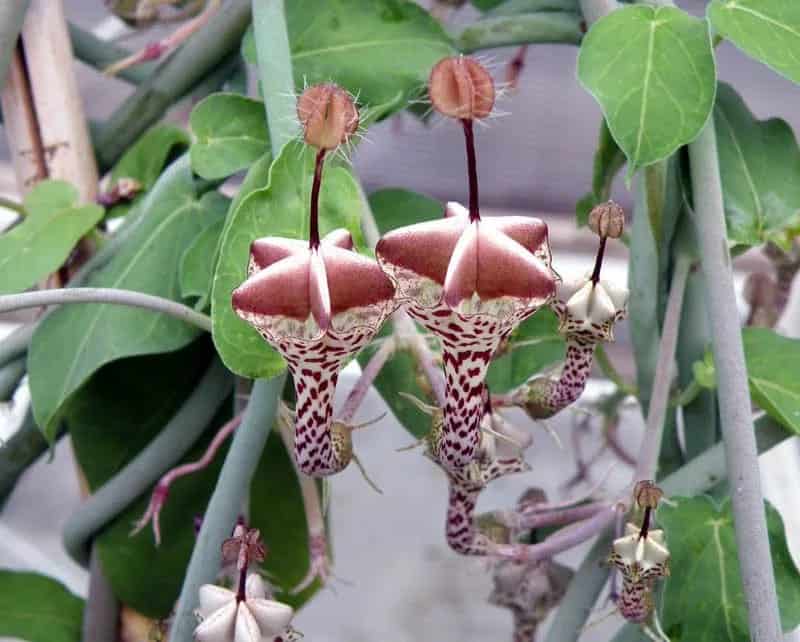

Sanderson's ceropegia (C. sandersonii) is a herbaceous vine with creeping shoots and thick ovoid leaves. Inflorescences are few in number, consisting of flowers with subulate petals, forming a light green-cream corolla, reminiscent of a canopy of a parachute with a ciliate edge.
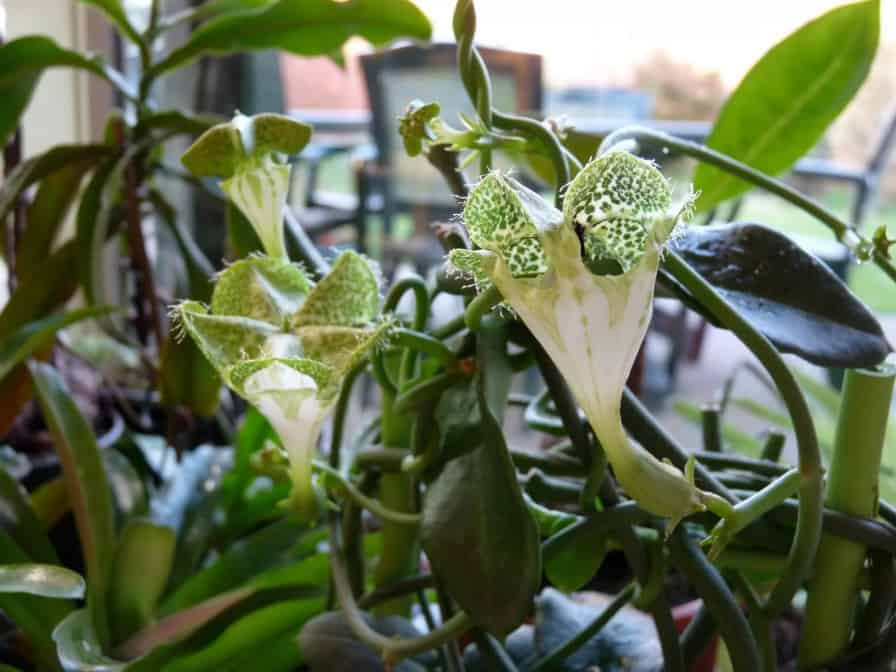

Ceropegia Fusca (C. fusca) is an exotic species native to the Canary Islands with thin grayish-green erect pagons covered with a waxy layer. They remain leafless for most of the season.


African ceropegia (C.africana) is a herbaceous vine with fleshy burgundy stems and very picturesque heart-shaped leaves, in which emerald raised spots appear on a silvery background, and a purple-green border stretches along the edge of the plate. The flowers are pink-purple, tubular, widened at the base and fused at the apex, decorated with dark cilia.


Stapeliiformis ceropegia (C. stapeliiformis) is a perennial with creeping stems, round in section closer to the base and triangular near the apex. The leaves are small, with small stipules. Inflorescences consist of 2-3 tubular corollas, swinging open with long sharp petals of white-dark purple color.
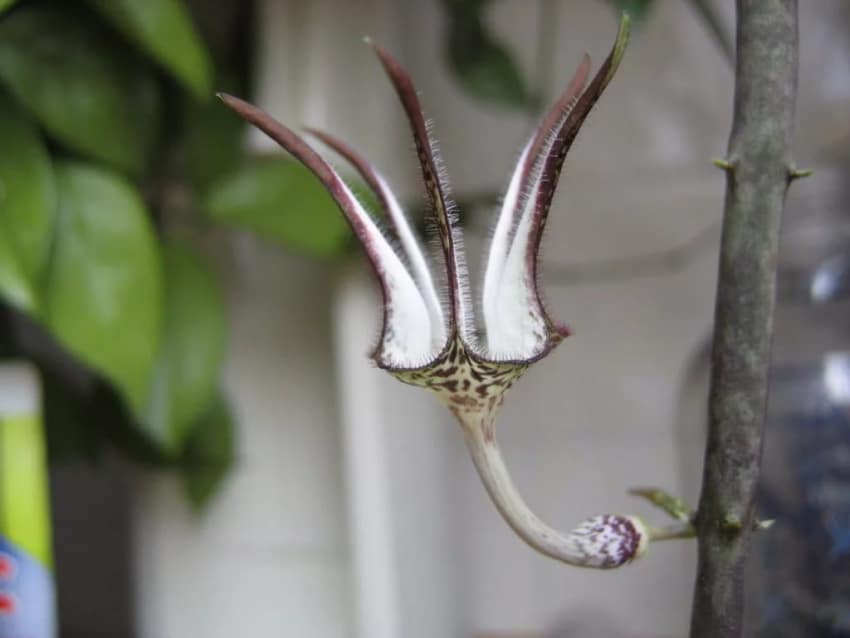

3. Varieties:
3.1.Ceropegia Wood - Ceropegia woodii
An evergreen plant - liana up to 4 m long with thin, flexible, abundantly branching stems. Leaves are cordate, on short petioles, green with silvery or pinkish spots. The underside of the leaf blade is often painted in a contrasting burgundy color. On the stems, as in the root system, thickened tubers sometimes form, which can be planted. The flowers are pink, lilac or burgundy, with 5 petals, of an extremely unusual shape, up to 3 cm long. This subspecies is the most common at home.
↑ Up,
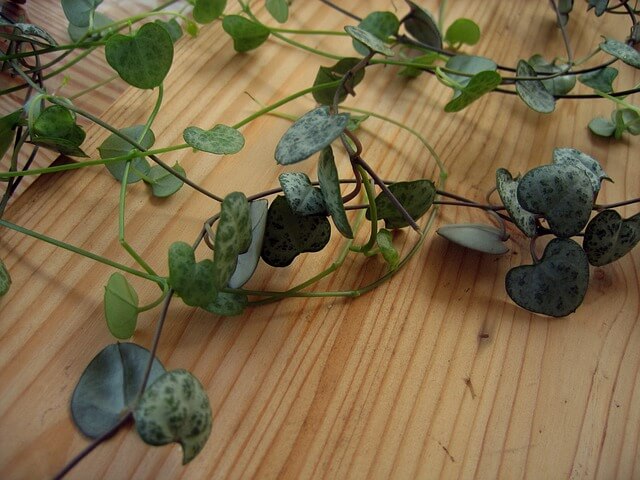

3.2 Ceropegia sandersonii
This subspecies has a unique appearance - the plants have long, green, chaotically curved shoots up to 4 m long. The leaves are green, heart-shaped, often one, even a large adult plant has only 2 - 5 leaves. The flowers are single, large - up to 7 cm long, yellowish - green, spotted.
↑ Up,


Botanical portrait
Most ceropegia are herbaceous perennials with thick tuberous rhizomes that store moisture, and erect or climbing succulent pagons, on which juicy oval or heart-shaped leaves are opposite. The color of the crown is deep green, but variegated ceropegia is also found with a pattern on the leaf blades of a cream, yellowish or marble shade. In some species, tiny bulbs form in the leaf axils, which, after contact with the soil, can grow and release roots in conditions of high humidity.
Flowering stems also appear from the leaf axils and bear single flowers at the top or small umbellate inflorescences of tubular corollas widened at the base. The petals are often accreted both below and at the top, forming a kind of trap for pollinating flies. Thanks to such a wonderful shape, the ceropegia flower has many popular names, for example, parachute, lantern flower, beach umbrella, snake liana, antenna, necklace, rosary plant and others. Fruits are fusiform or cylindrical leaflets.
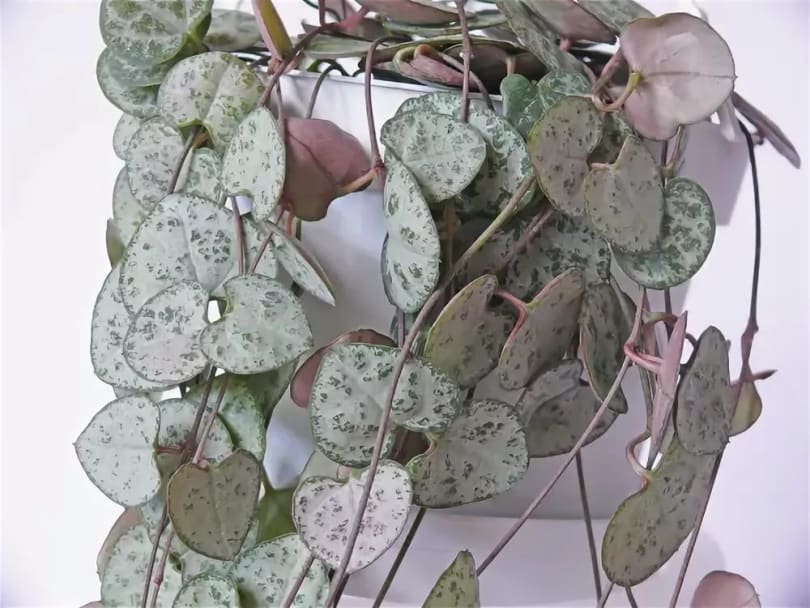

Ampliata
Peperomia Lilian Caperata - home care
Ceropegia Ampliata is a climbing plant with absolutely bare shoots. This species has small, scaly leaves that fall off rather quickly. The corolla tube looks like a white and green tiara because of its shape. These are five perianth petals, whose tips have grown together.
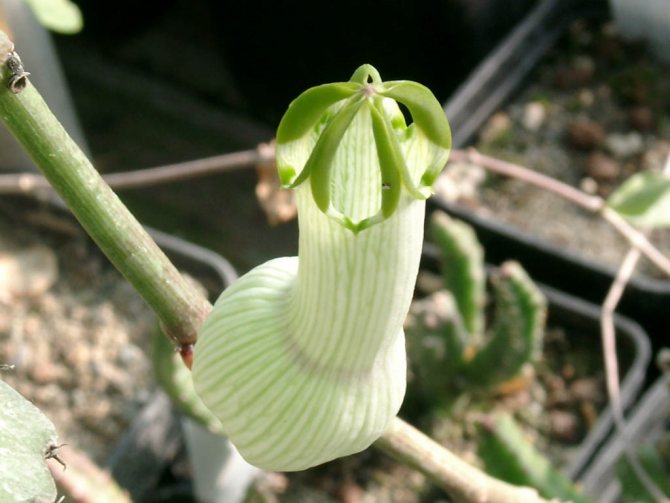

Ampliata view
Note! According to many gardeners, the Ampliata type of ceropegia (or, as it is also called, extended ceropegia) loses in external beauty to other plants of its kind.
Crown formation and flowering of ceropegia.
Form ceropegia by pinching. The decorative appearance is maintained by pruning weak, thinned and old shoots.
Ceropegia blooms almost all year round, but only with proper care and sufficient lighting intensity. The flowering of this liana does not represent any particular decorative effect, therefore, ceropegia is cultivated mainly only because of the original, unusual appearance, sometimes even simply removing the flowering.
Usually every 5 years this vine is renewed by rooting cuttings.Do this if the plant has grown a lot and has lost its attractive appearance.
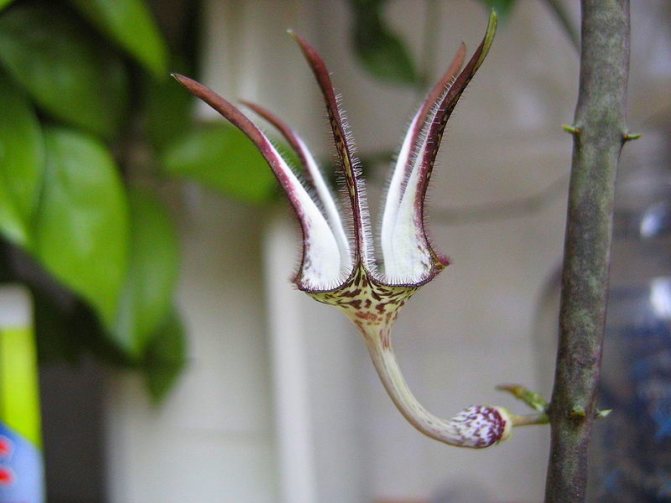

Ceropegia stapeliiformis. <>
Linearis
Hymenokallis flower - home care
Many people who are professionally engaged in floriculture note that the type of Ceropegia Linearis is very similar to Wood's ceropegia. At the first glance at the plants, you can see almost the same long and thin shoots that braid the support, and shiny leaves, which are shaped like a heart. An important difference is the absence of light spots on the stems and the leaf blade in Ceropegia Linearis.
Note! In some varieties of Ceropegia Linearis, the leaves have a special color: with a pink edging and a green core. You can also find Ceropegia Linearis, the leaves of which resemble the leaf plates of cyclamen.
Useful properties of ceropegia
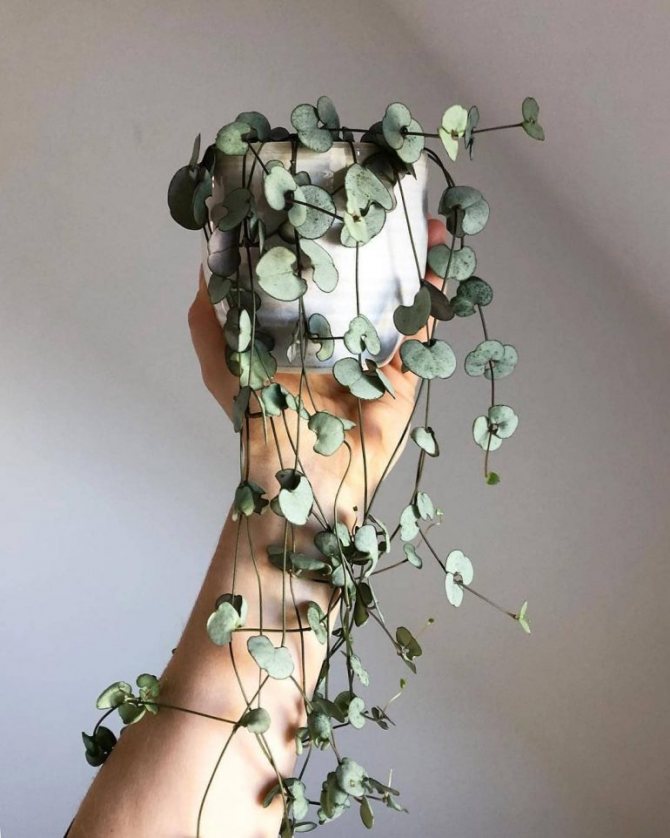

Ceropegia Wood. Photo
This is an amazingly flexible liana-shaped flower, which, with the help of supports and decorative stands, can be given absolutely any shape that successfully complements the interior. In addition to its decorating properties, ceropegia is a natural air purifier that absorbs harmful toxic compounds.
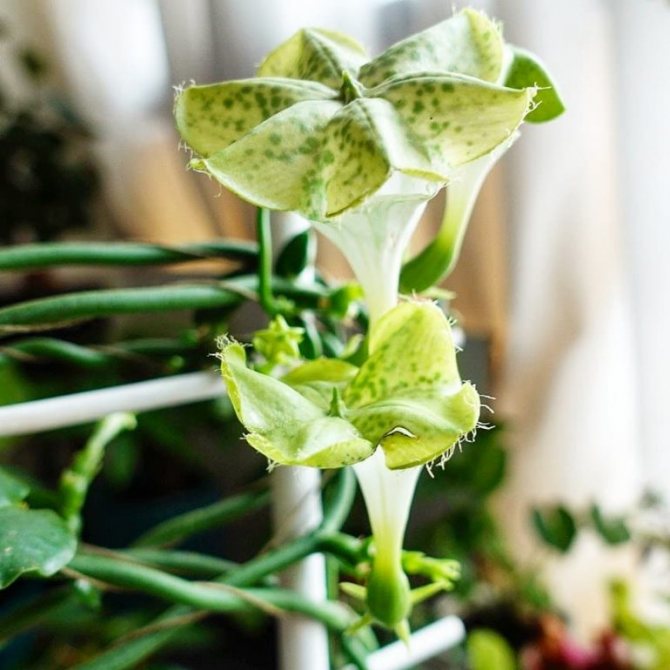

Sanderson's ceropegia. Photo
Brief description of cultivation


- Bloom... With good care and optimal growth conditions, Ceropegia blooms almost all year round, but its flowers are not highly decorative.
- Illumination... Needs lots of bright sunlight. In the summertime at lunchtime, when the sun is most active, the bush needs a little shading.
- Temperature regime... During the growing season, the air temperature should be between 20 and 25 degrees. With the beginning of autumn, the temperature should be gradually reduced, and in winter it should be at the level of 14 to 16 degrees, but not lower than 11 degrees.
- Watering... In the spring-autumn period, the plant is watered moderately immediately after the top layer of the soil mixture dries out. In winter, the number of watering is reduced, and the substrate is moistened only when 3 days have passed since the drying of its top layer.
- Air humidity... It can be anyone.
- Fertilizer... You do not need to feed young bushes. Adults, on the other hand, need regular feeding, which is carried out in the spring-summer period every 20 days. To do this, use a solution of mineral fertilizer for orchids or succulents, while taking ½ part of the dose that is recommended by the manufacturer. During the autumn-winter period, fertilizers are not applied to the soil mixture.
- Dormant period... Not pronounced, observed in winter.
- Transfer... While the young bush is transplanted annually in the spring, the adult plant does not need frequent transplants, they are carried out only if necessary.
- Reproduction... Cutting, dividing the rhizome and seed method.
- Diseases... Fungal rot.
- Harmful insects... Mealybugs, spider mites and aphids.
Varieties
Ceropegia Wood (Ceropegia woodii)
Of all those grown at home, this is the most common type. It has beautiful marble-colored leaves that, when unopened, resemble green or purple beads. It blooms regardless of the season, the flowers open in the axils of the leaves and resemble an extinguished candle.
In summer, small glomeruli can be seen on the branches. If such a glomerulus falls on the soil, it will give roots and form a daughter plant. The roots of an adult plant are similar to the tubers of a potato. They are very convenient when transplanting - they do not react to changes in position. For a grower who does not have the opportunity to spend a lot of time caring for a home flower, Wood's ceropegia is just a godsend.
Cerepegia wood is an ampelous plant, but the branches are quite plastic and fit well on a simple shape, which makes it even more decorative. But when transplanting or dividing a bush, the branches must be carefully unraveled.


Ceropegia Wood
Ceropegia sandersonii
Differs in long, smooth, fleshy stems that have a rich green color. Small dense dark green leaves are arranged in pairs rather rarely along the entire height of the stem. The branches must be supported, otherwise they will break easily. As a support, you can use dry tree branches, the original pattern.
Flowering of Saderson's ceropegia lasts all year. Fresh buds appear in the place of wilted and fallen flowers. The flowers are very decorative: five fused petals form a shape that resembles a flashlight. A fringe of villi is visible along the edge of the petal. The flower is very delicate and extremely attractive. Its modest beauty pleases the eye all year round.
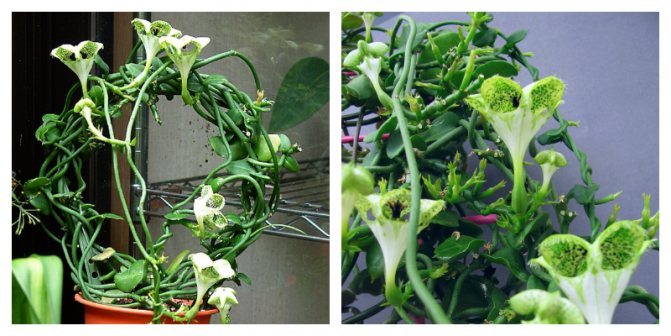

Sanderson's ceropegia
African Ceropegia (Ceropegia afrikana)
With its drooping shoots, it resembles a fat woman growing not up, but down. And the leaves differ only in the pointed tip. Stems grow from tubers that lie only half in the soil. Flowers, like all ceropegia, have a tubular base and top of fused petals. Only they are much smaller - only about 2 cm.
Perfect for creating mini-gardens in an exotic direction. It is combined in care with many succulents, which makes it possible to grow them together, in one container. Ceropegia is a perennial plant that does not require frequent transplantation. This is important when designing a garden of exotic indoor plants.
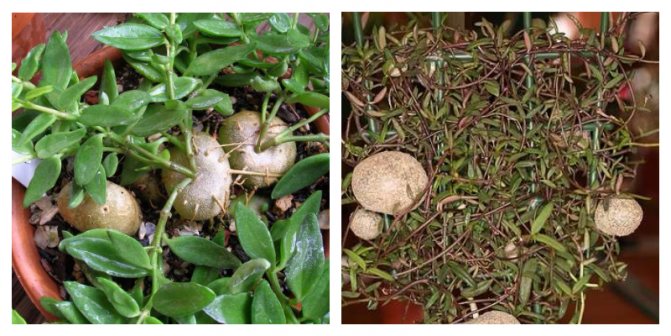

African ceropegia
Stapeliiformis ceropegia (Ceropegia stapeliiformis)
Of all the types of ceropegia, the most interesting. The appearance can even scare an inexperienced person. Thick, three-ribbed stems with antennae at the tops, almost no leaves, and therefore this plant can be mistaken for an unknown reptile.
But good, collected in small inflorescences, white flowers, decorated with purple specks. Flowers differ from other species in that they do not grow together at the top, but form a small crown. This ampelous succulent may become the first number in the collection of exotic plants lovers.
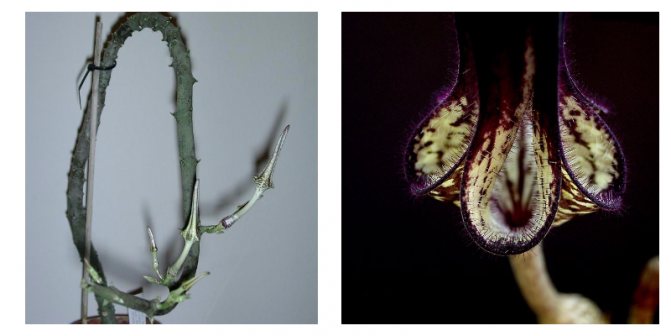

Stapelliform ceropegia
Ceropegia Barkleys
Differs in softer vine branches. The pinkish-silver twigs have many airy nodules. They are easily separated from the base, so the plant reproduces well. Leaves are rare, small - 2.5 cm long, sometimes up to 5 cm. This is a purely ampelous plant, it will look better in a flowerpot on the wall.
As in all types of ceropegia, the flowers are an elongated tube, ending on top with five fused petals. Their greenish-silvery color makes them not very noticeable against the background of leaves and stems.
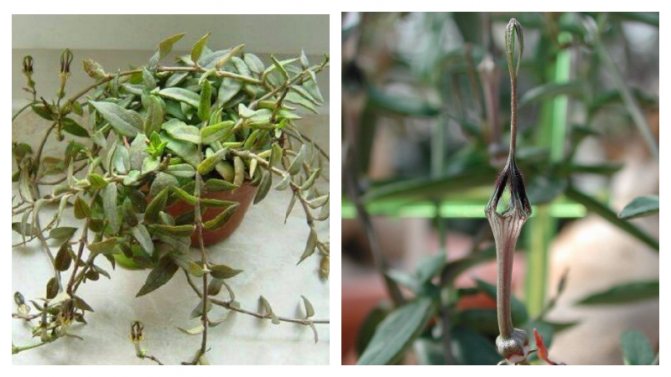

Ceropegia Barclay
Plant transportation, reproduction
The most important rule is to change the pot for a young flower once a year, and for a mature one - in several years. When transporting vines, in no case should the roots be damaged, and therefore usually several people are engaged in this at once.
Here are several ways to propagate a plant:
- stalk (most often used in floriculture);
- division of roots;
- seeds.
Note! Usually breeders are engaged in the reproduction of plants of this genus, since this process requires a lot of effort, time and expense.
Ceropegia are amazing plants that are unpretentious and suitable for any novice florist or ordinary person who wants to decorate their home with exotic flowers.
Wood
Wood's ceropegia (or, as it is also called, Woody's ceropegia) has gray tuberous roots, which often surprise novice growers with their similarity to potato tubers and purple creeping stems.
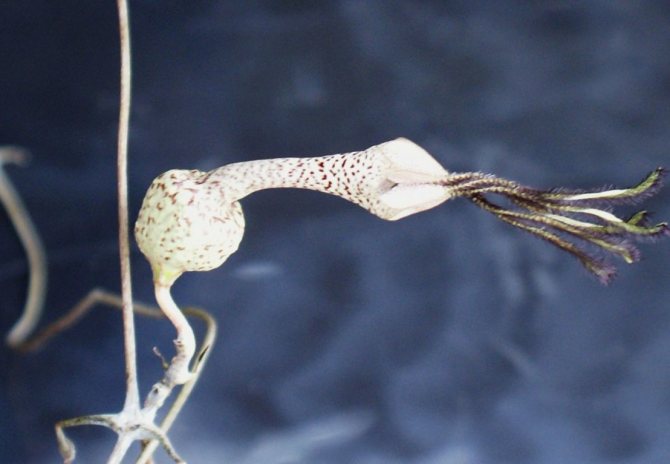

Flower appearance
It has dense, fleshy foliage 15 mm wide and 20 mm long, usually triangular or ovoid. The leaves are marbled on one side and greenish or purple on the other.
With high humidity, roots appear on the tubers of the plant, which are later used for reproduction of the ceropegea. Also, Wood's ceropegia is notable for its small but very beautiful flowers with a light flesh-colored corolla and dark brown petals. They bloom throughout the year with proper care.
Important! At Wood's ceropegia, home care and cultivation are possible in hanging pots or on stands. It is also advisable to plant different plants away from each other, since it is very difficult to untangle their stems. Therefore, it is better not to create a situation in which they become entangled into a single whole.
All ceropegias require the same care without frills, which is why flower growers love them so much.
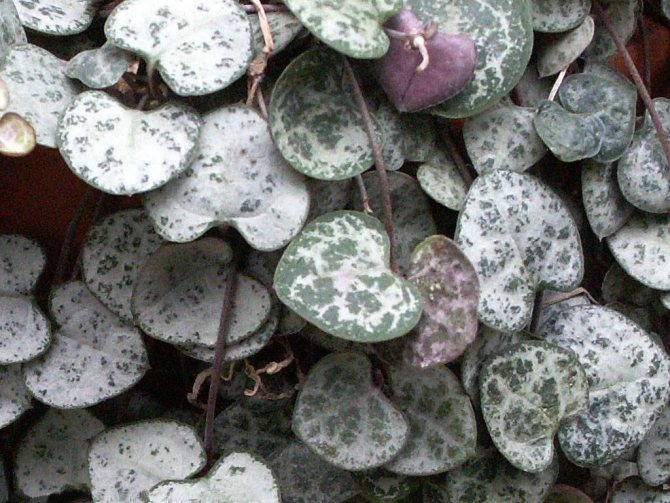

Wood variety
Variability
All species belonging to the genus Ceropegia are variegated. This means that the leaves contain mutated cells that are unable to synthesize chlorophyll. It is for this reason that white spots appear on the stems and leaves (where these cells are located). Most variegation is observed in Wood's ceropegia, which, as noted earlier, has an unusual color.
Interesting facts about Wood's ceropegia
Air nodules on the stems of Wood's ceropegia appear within six months after planting. Tubers on the roots are formed within 3-4 months.


Roots of Wood's ceropegia
The plant can be propagated by small cuttings with 3-4 internodes. The main thing is not to abuse it with watering, otherwise the young plant will quickly rot in the soil.
Fallen or damaged leaves are not restored. Bare stems look ugly. In such cases, it is recommended to cut the plant and root it again.
The culture branches very well, from time to time launching new stems from almost every axil.
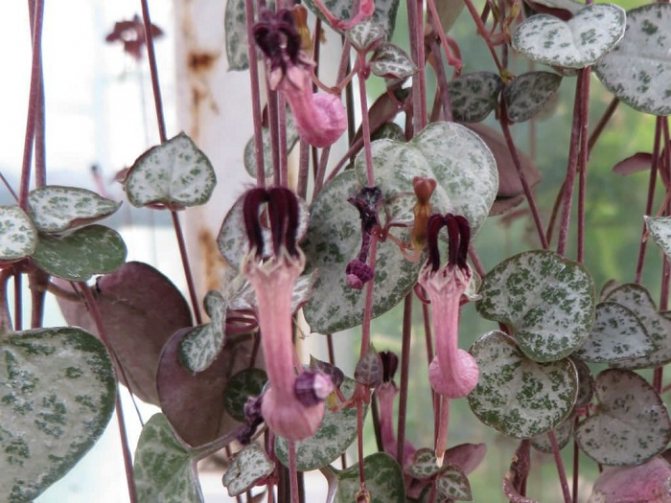

Ceropegia Wood in vivo
In natural habitat, most of the ceropegia during the flowering period emits a very unpleasant, putrid odor. It serves as a means of attracting flies to pollinate the flower. When kept at home, it is almost impossible to feel the specific "aroma" (unless, of course, you do not bring the flower close to the nose).
How to properly plant ceropegia
The vines have an intensively developing root system, so the need to transplant young plants arises every spring. More mature specimens are transplanted every 2 or 3 years.
Choosing a flower container
When choosing a flower pot, take into account the size of the rhizome. The tubers should fill the interior of the vessel so that the distance to the side walls remains at least 2 cm.
It is advisable to choose earthenware or ceramic, for such a dry-loving flower as the same Wood's ceropegia or its other variety, it is important that the root system is not exposed to waterlogging. In plastic containers, the earth clod dries out more slowly. Be sure to use expanded clay drainage at the bottom of the pot.
Compilation of soil mixture
The substrate for growing ceropegia should be light, loose and breathable. In the assortment of flower shops, you can choose the appropriate mixture for cacti or succulents from any of the manufacturers. It may be necessary to add a certain amount of sand to it to improve aeration.
For self-preparation of the substrate, humus soil, peat soil, leaf humus are taken in equal volumes, 15% of coarse-grained river sand and some medium-small pieces of charcoal are added.
During planting, the tubers are neatly placed over the drainage and a small layer of the substrate, sprinkled on top with the remaining soil mixture so that the rhizome is completely covered with earth, although in some species it is allowed to locate the tubers partially above the level of the earthen coma.


What are the requirements for the content of ceropegia?
Succulent is very photophilous and develops well only with sufficient lighting.However, under the bright sun, burns of the delicate tissue of the surface of the leaf blades easily occur on the foliage. In the room, they try to place the ceropegia so that it receives a lot of light, and at the same time does not suffer from its intensity.
The optimal thermal regime for vines is 12-24 degrees, and the winter content should not only be cool - up to 15 degrees, but also dry. The critical temperature for a succulent is 10 degrees above zero, it is advisable not to allow less, otherwise the foliage crumbles and the tubers die.
Care features
Ceropegia reacts very painfully to stagnant air in the room, therefore, along with traditional care measures, you should often ventilate the room in which the succulent grows.
Watering and air humidity
The environment for growing ceropegia requires a dry one, so additional means of increasing air humidity are not only not needed, but, on the contrary, can harm a succulent vulnerable to rot.
Careless abundant watering can quickly destroy a flower, therefore, the florist should be extremely careful about the irrigation regime of ceropegia. In summer, ceropegia is watered once a week when the earthen lump dries out. In autumn, moisture is reduced to 1 time per decade, and in winter it is watered twice a month, or even less often, depending on the temperature in the room.
Top dressing
During the active growing season, the liana is fed with complex fertilizers for succulents and cacti every 2 weeks. They try to avoid formulations where there is a large percentage of the nitrogen component. During winter dormancy, feeding is stopped.
Trimming, need for support
Ceropegia is grown as an ampelous plant, placed on an elevated stand or suspended in a flower pot. If the plant is installed on a windowsill or table next to the window, it will be equipped with a support, otherwise some cultivated species cling to the curtain with antennae. It will not work to tear them off without damaging the fragile pagon.
In the spring, pagons can be shortened if they have grown too long in the previous season. Cut fragments of the stems are used for propagation, cutting into several cuttings.
They try to cut off withered inflorescences in a timely manner, stimulating the formation of new buds. Having created favorable conditions for care for ceropegia, you can achieve frequent flowering.
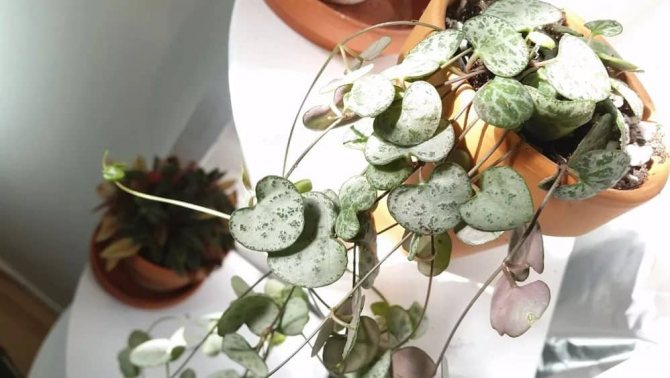

1. Seven Secrets of Success:
| 1. Growing temperature: throughout the year, Ceropegia is grown at room temperature ranging from 18 to 24 ° C. |
| 2. Lighting: A brightly lit location with no direct sunlight during daylight hours. Liana can sunbathe in the morning and evening. |
| 3. Watering and humidity: regular watering in the warm season, the top layer of the substrate 3-4 cm deep must have time to dry out before each subsequent watering. Significantly reduce your watering frequency during the winter months. The air humidity does not need to be increased. |
| 4. Features of the: despite its exotic appearance, ceropegia is unpretentious and easy to grow at home with not too burdensome care. |
| 5. Priming: nutritious and well-drained soil, easily permeable to moisture and air. |
| 6. Top dressing: we feed in spring and summer every 2 weeks with mineral fertilizers for succulents and cacti. In the fall, the frequency of fertilizing is gradually reduced and in the winter months it is stopped completely until spring. |
| 7. Reproduction: sowing seeds in spring, separating stepchildren, stem cuttings. |
Botanical name: Ceropegia.
Ceropegia flower - family... Gully.
Origin... South Africa.
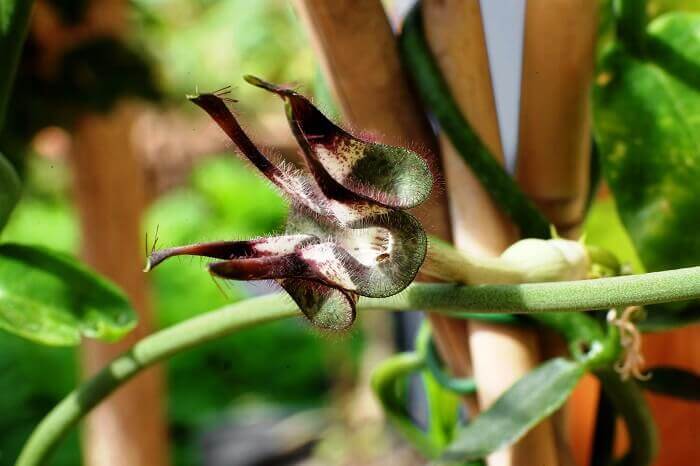

Description. Ceropegia is a very extensive and diverse genus of plants, among which there are perennial evergreen and semi-deciduous vines. Ceropegia has thin, branching shoots. Leaves are thin, heart-shaped, located on short petioles. The color of the leaves varies from solid green to burgundy and green with various specks.Often the underside of the leaf blade has a contrasting shade. The flowering of ceropegia is extremely unusual - its flowers resemble lanterns. Ceropegia belongs to succulent plants, as it often has a tuberous root, which serves the plant to store moisture and nutrients.
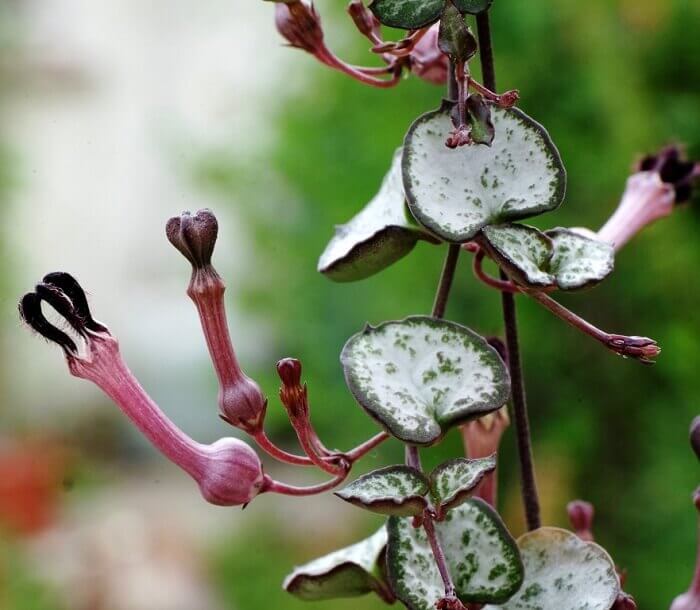

Height... Stems reach a length of 2 - 4 m, grows relatively quickly.
Features of growing ceropegia
Before planting ceropegia at home, you need to know a number of rules and features in growing:
- Like all succulent plants, the rhizome of ceropegia is capable of absorbing moisture. Therefore, waterlogging and stagnation of water in the soil should not be allowed. Such plants are susceptible to root decay.
- Every 2-3 years, an adult plant needs to be replanted, and young shoots are planted once a year in the spring.
- With good care, the flower grows quickly - the shoots become long and can get confused. Therefore, it is necessary to provide a support for the vines in advance.
- To create a lush shape, when transplanting, it is better to take several tubers in one pot.
- Ceropegia does not like stagnant air - you should periodically ventilate the room in which it is located.
- The plant is very fond of sunlight. Then it willingly blooms with large flowers. In winter, it is advisable to illuminate the plants with lamps.
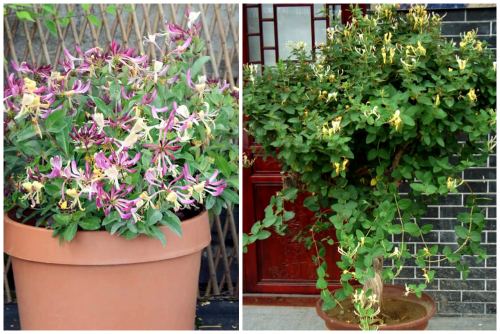

Features of ceropegia
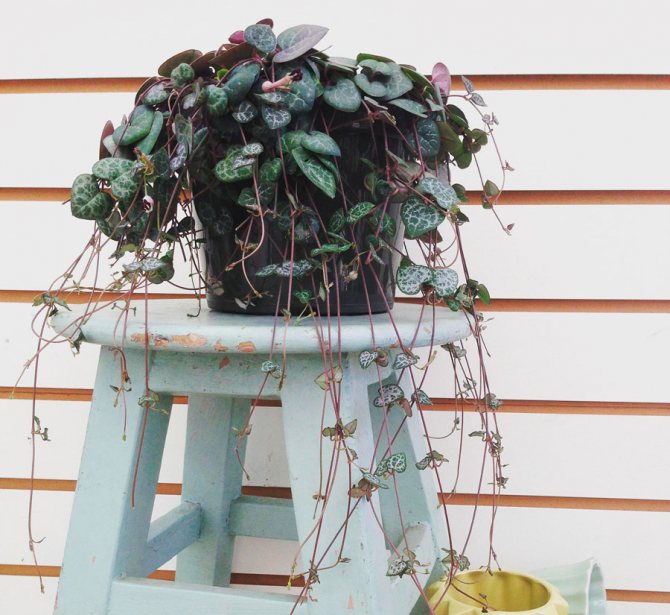

Ceropegia is a herbaceous perennial plant that can be climbing or erect. The rhizome has a tuberous or thickened spindle-shaped form, there is an accumulation of moisture in reserve. Such a plant has creeping and fleshy shoots. Opposite thickened small leaf plates have a linear, ovoid or lanceolate shape. In most species, shoots and leaf plates are succulent. As a rule, the juice of such a plant is transparent, not milky. Umbellate or racemose inflorescences consist of large five-membered axillary flowers, their corolla is tubular at the base, expanded. In the flowers, the stamens have grown into a tube. The fruit is a fusiform, cylindrical or linear leaflet.

